The Democracy of Touch: Game-Maker and a New Beginning
So if you haven’t heard, RSD Game-Maker has now gone open-source. In this Gamasutra blog post I get a little carried away, talking about this event and its blue-sky potential.
So there it is!
So if you haven’t heard, RSD Game-Maker has now gone open-source. In this Gamasutra blog post I get a little carried away, talking about this event and its blue-sky potential.
So there it is!
A few years ago, on the tapering end of my active involvement in game journalism, I spent around a year contributing to a budding indie game blog called DIYGamer. It kept my attention for a while, forced me to write more than I otherwise would have, and drew my eye to many interesting new game projects. Then I found other things to do, and I drifted away.
I just learned that the site was discontinued about a year and a half ago, and that it was taken down… well, recently. I swear it was up a few weeks ago.
Luckily, having been bitten many times by the vanishing website bug, I previously archived all of my articles as originally published. (Seriously, everything that I write for soon goes out of business. What gives?) Here, then, is a roughly organized record of my time with that site. Later I may update the links buried in this site. Or maybe not.
EDITORIALS:
INTERVIEWS:
REVIEWS AND PREVIEWS:
NEWS:
THE GAME-MAKER ARCHIVE:
To catch up on the story to date, you can view the archive here.
There are at least three ways to give up. You can dial down your ambition and just putter. You can change plans and try something different. Or, you can just stop.
By the end of my Game-Maker tenure I had shaken free of some of my more rigid ideas, and thanks to a few high-intensity bores I had learned not to invest more of myself into a project than I got back from the buzz of creation.
Indeed it seemed like my best work came when I had no investment at all. The more motivated I felt to complete a project, the more narrow I found my thinking. When I was focused on a goal I would pay little attention to a game’s moment-to-moment dynamics, to the player’s role, to whether or not a design element actually worked, or more generally to whether or not the game was fun or rewarding to play.
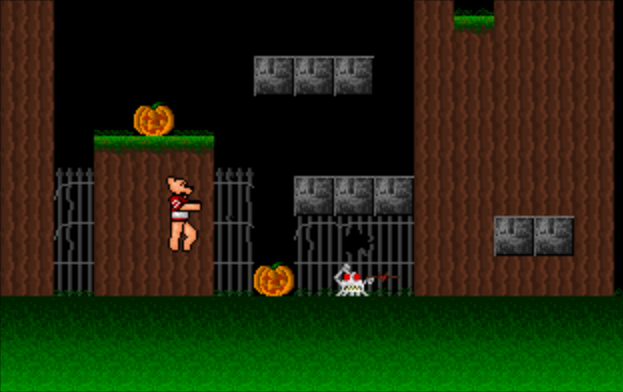
I would rush the visuals and level design just so I could call them done and move ahead. When I added content, it stayed in because it would take too long to edit it out. Anyway, more is better! What’s the point of working backwards?
With focus came an obsession with doing things “right” — which at that time meant imitating something familiar to me, usually an existing game that I enjoyed. I figured if I wanted to be taken seriously I had to produce a recognizable game; one as good as the competition’s.

Then, sometimes, I gave up — and freed from the confines of reason, my subconscious came out to assert itself.
This final chapter is about giving up. We touched on this in the previous chapter, when after the ambition of games like Ninja Tuck and A-J 3 I chose to back away from Game-Maker, at least from serious attention, until some of my concerns were addressed and I had a grander tool set to match my inflated plans. That update never came — and during the long wait my attention shifted to the small things, like controls and level design.
That snit was hardly new. I went in and out of these moods. In a sense they shaped my design career. For a few months I would plug away at a pattern that seemed to work; then I would realize that it didn’t quite. I would burn out, and then manage my discouragement by changing the tune. I would toy with something different — something silly, for which I had no real expectations. And what do you know, in hindsight these were the games that really mattered.
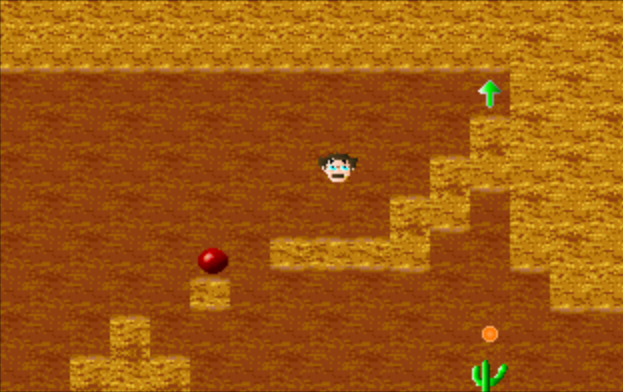
The games that we will discuss here are the oddball projects that do something a little different from what I knew at the time. These are the turning points — when I gave up, when I let go, and when I grew a little bit as a designer.
The pattern began way back, just a few months into my work. With A-J’s Quest I had produced the game that I bought Game-Maker to produce. It wasn’t perfect, but it was good enough. My goals completed, I set out to milk my purchase by showing it off to my friends. In the process I hit several walls. I had some very specific ideas, and I couldn’t find a way to implement them. I felt stuck, and could see no way out besides waiting for improvements to the game engine — so my attention drifted.

I fell back to Deluxe Paint, a program that I felt I had mastered and that had carried my attention since middle school. At that time I had a stockpile of images and brushes; I knew all about palette cycling and gradients. Unlike Game-Maker I felt no boundaries there.
With my mind on drawing, at last I noticed RSD’s Graphics Image Reader, a tool for importing .GIF images and palettes into RSD’s own formats. To that point I had ignored it, as RSD’s drawing tools were good enough and I wasn’t really up on image file formats.

Around here, though, I discovered the modem on my father’s 286. Day after day I would dial up local boards and explore their download directories. I found image management tools like Graphics Workshop (sort of the Adobe Lightroom of its day), and I found extensive libraries of 320×200, 256-color .GIF files. Some of them were even photographs — and such clear ones, at that!
I began to convert my own Deluxe Paint illustrations to .GIF files, to upload them for board credits. While I was at it I tinkered with RSD’s importing tools. There are a couple of ways I could have tackled this. What I wound up doing was adapting my Deluxe Paint brushes into Game-Maker sprites. When it seemed workable, I would rescale one of my larger drawings and turn it into its own sprite.

Parallel to this, I got my first sound card — a new Sound Blaster Pro. It came with a rather clean, user-friendly tool for recording Creative’s proprietary .VOC format, which happened to coincide both with the demands of RSD’s engine and with the format of online sound libraries. So while I filled my junk drawer with random externally derived sprites, I also built up an archive of random audio samples. Some of them were original; some derived or taken from online libraries.
After a few months these archives achieved a sort of a critical mass, and I figured it was time to either make use of them or to move on to other projects. Thus the brushes became monsters and the samples became a sound set. Groucho Marx, pushpins, sugared cake doughnuts, and biplanes were ready to terrorize a minimal-effort landscape. To create the levels, really I just drew two tiles — a foreground and a background — and then blurred a few edges between the two.
That just left the matter of a protagonist.

During all of that .GIF importing, I experimented with a few downloaded or demonstration images. One in particular, a slightly terrifying close-up of a clown face, became a focal point. I tried to import it and chop it into tiles. That didn’t work. I tried to shrink it down into a 20×20 sprite. The result was… strange. So I compromised; rather than importing the whole image, I picked a key feature — the clown’s red, shiny nose.
With a bit of editing, I had what I felt was a photo-realistic bouncy ball. For no sane reason I also selectively imported the clown’s eye, and animated a sequence where the nose turned into that eye.

Add in a few laser effects, assign the random sound samples to in-game actions, write a bizarre narrative justification for the proceedings, and we have The Bounerim.
For all its random origins The Bounerim is the project where I began to understand 2D platformer design. After A-J’s Quest and its more-of-the-same sequel it was my third attempt at a the genre — but those were a special case, designed in my head years before I had the tools to produce them. The Bounerim demanded that I think through the genre’s mechanics and implement them anew, and more than A-J’s Quest it established the style and techniques that I would use in all of my later games.

Of those, the most direct descendant would probably be Crullo. It’s got similar mechanics and a similar kind of a protagonist (based on the same brush used for one of Bounerim‘s monsters). On another level, Crullo is the first time that I really used Deluxe Paint as a primary tool for background and sprite design — whereas The Bounerim is the game that set that ball rolling. As it were.
Of course use then turned to overuse. For me Deluxe Paint became a shortcut, which set a precedent for all my working habits. At the time it seemed like a gift. This was an intense period; I had only a month to plan, build, and deliver six games and sundry resources. It was tough to focus. Each game was meant to show some aspect of RSD’s engine. One would play with monster types; another, styles of background block. In the end I was distracted by scale and glitz, and spent my time on showcase games that failed to live up to their goals.
Had I more time, or had I better used what I had, I had more and better plans than the ones that came to bear. The best of those harked back to my first glimpse of RSD’s software, in those ads in the back of VideoGames & Computer Entertainment.
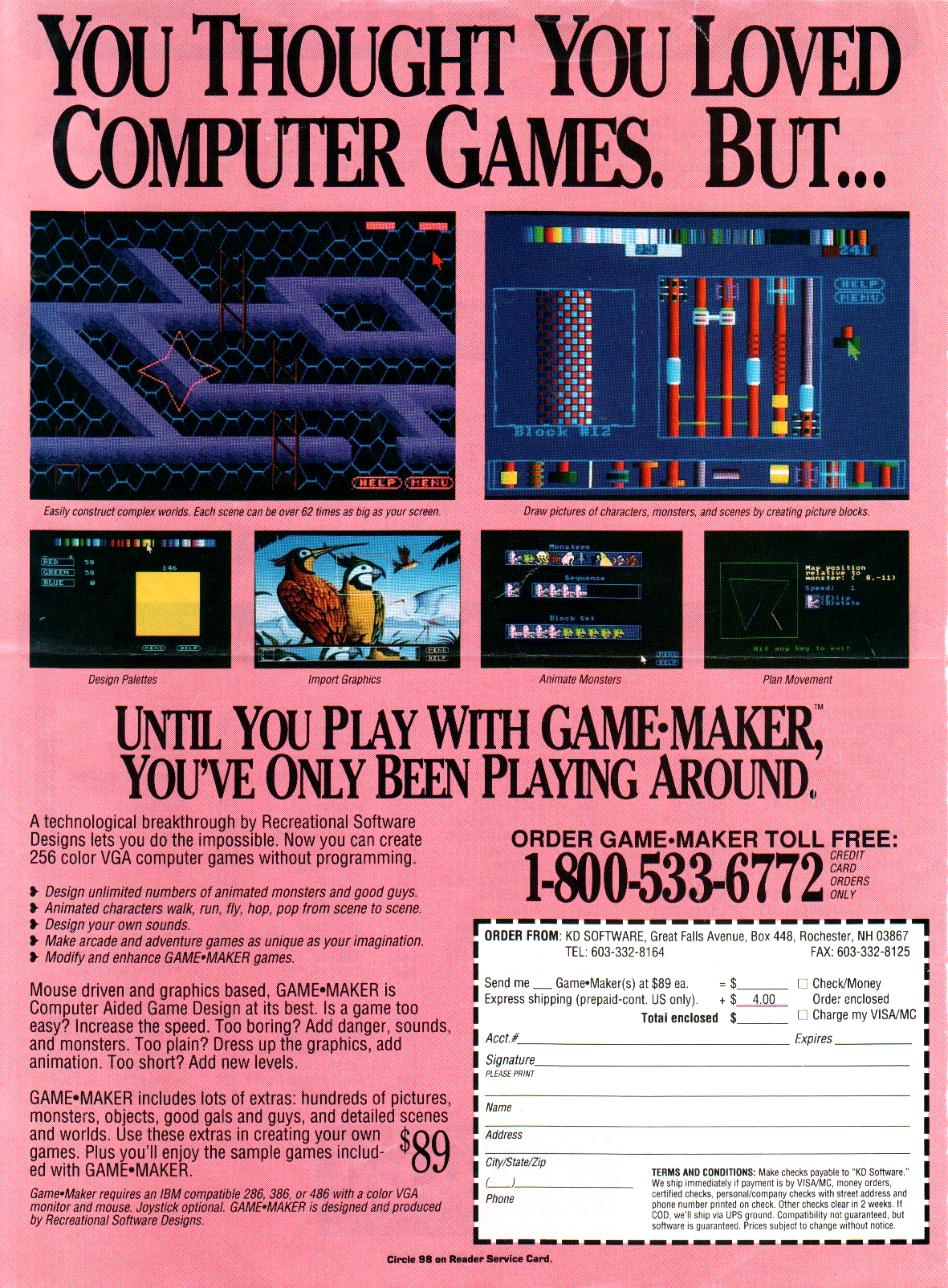
I’ve talked of how those shots caused my mind to race. They spoke of magic and variety, like a trip to the arcade or the front desk at Kay-Bee Toys, or a new disk in the mail filled with unknown surprises. In particular the image of Block Designer, its sandbox window filled with tiles from G. Oliver Stone’s Pipemare, called to mind radically diverse games like Tower Toppler, Alleycat, and Arkanoid — none of which, as it turns out, Game-Maker was meant to replicate.
Still that hypothetical game stayed with me — something involving towers and bridges and inscrutable barriers. It was a vertiginous thing where the player passed in front of and behind objects, collected power-ups, and found the best and safest route skyward. The game had never existed, and yet I found it indelibly linked with Game-Maker. If I were to produce demo games, I could do worse than to fill that blank.
All through the summer that game danced across my mind yet never quite landed. It would be something to do with poles and gravity — leaping or climbing from pole to pole, as on a giant jungle gym. Scattered around the poles would be obstacles, threats, and bonuses. The pieces never meshed, and there was always something else to do. Then came the deadline, and in the following burn-out any spare ideas just melted away.

There followed a long period of inactivity. I went back to school; I started to make friends and do things. I began to listen to music, and to try to write my own. By the next spring my mind was rested — so when I approached Game-Maker, I did so from a new angle.
I started again. The previous summer I had tasked myself to break down Game-Maker into its constituent elements, so as to show off its properties. That notion returned with a new clarity, and I went back to basics. My new game would simply explore the engine’s physics. Gravity could go up or down, or it could be static. Tiles could be solid or not, on various sides. They could injure or heal; increase or decrease counters. They could animate, and change on contact with the player. These would be my limitations; rather than fight against the engine’s boundaries, I would demonstrate its features.
I drew every tile by hand, in RSD’s own tools. Although I used Deluxe Paint for the menus and splash screens, I restrained myself to just a few colors, simple geometry, and a consistent shading technique. Every element was new, every piece was simple, and every part of the game served to illustrate the basic concepts at its core. The result was an action puzzler called Friction, which — some quirks aside — may also be the finest game to rise from my Game-Maker career.

As I focused on the background physics, I focused on the environment. As I took pains to clearly demonstrate the physics, it happened that I found a sense of level design. For possibly the first time I agonized over a game’s maps. Each tile had to be placed just right, and to stretch out and highlight the fairly limited palette of concepts I had to introduce them carefully, one at a time.
Whereas most of my games had been object-oriented — they were about the character, or about mimicking a game that I liked — Friction was all about the subject. The story, the character, the visuals all served the game’s central purpose as extrapolated and narrated by the level design. Since I had extrapolated that purpose from the engine rather than imposed it upon Game-Maker, I also hit fewer of the engine’s limitations — meaning those limits showed less clearly. By embracing the given boundaries, Friction is one of my few games not to feel defined by them. In that sense I would consider it my first mature design.

It had its problems, of course. Even with all of my concessions I felt that the engine did not want to work with me. Due to issues with the physics and certain “features” like the helpful way that characters bump their way around corners, I had trouble keeping the character aligned with the ropes and poles. I also hit the Pac problem: due to the engine’s persistent counters, if the player picks up a key and then dies then he begins his next life with that counter still increased.
Thus puzzles are never truly reset, and the player can easily bank items for later use. In retrospect I suppose I could have placed a tile at the start of each level that drained any artificially raised counters — but I was not yet at that level of hackery. I was still approaching the engine in earnest, and I expected features to work as proscribed.

The game has a story, though it is of no consequence. I figured that anyone who would be inclined to acrobatically leap around on ropes and poles would be something of a daredevil; this brought to mind an old whimsy stemming from a DOS-based brainstorming and poetry generation suite, Rosemary K. West’s Thunder Thought and Versifier.
Basically this software called from a huge database of nouns, verbs, adjectives, and phrases. The user would choose a template and set a few variables; the software would randomly fill in the structure with content from the database. When I got the software I scrubbed the databases and then entered the bare minimum of my own content — which meant that the same words and phrases tended to recur with some regularity. One of the first proper nouns that I entered, which quickly became a joke, was a reference to a genial hot dog vendor in my home town. Through poem after poem, “Hank the Hot Dogger” went on wild adventures and learned deep life lessons. On the basis of his name, I figured he would make a good protagonist here.

By this point in my design career I was big on customization. If I was going to make something, I figured I might as well use all original elements. Whether they were any good or not, at least they were my own. Accordingly I recorded and edited all new sound effects which would have a long life in future Game-Maker projects, well beyond my tenure. I’ve lost count of how often I’ve heard the grunts and chomp sounds reused in other users’ games.
The only thing left to customize was the music. I’ve talked about this before, but here’s a missing chapter in the tale. Since its introduction to Game-Maker I had been frustrated with the Creative Music Format that RSD’s engine supported. As I now understand it, RSD had grander plans for music but Creative’s code was ready to hand so with a deadline at their heels they slapped it in to provide at least provisional support.
That would have been fine, as from an aural perspective CMF is a perfectly respectable format. It’s a sequenced format, like MIDI, that uses the Sound Blaster’s Yamaha FM chip — a close cousin to the chip in the Sega Genesis, one of my favorite sound chips in any game console. The problem is the lack of any obvious compositional tools. This means that nearly every Game-Maker game draws from a small pool of library tracks, in particular the six tunes that shipped with Game-Maker and the scores to several early Epic Megagames releases.

There were tools available, as I would later discover — some more practical than others — but the support wasn’t what it could be. Furthermore by the time I lost patience with the situation, other better music formats had become prevalent. Later Epic Megagames releases used Amiga-style module formats, which sounded great and were simple to compose. With Friction I felt I had played fair and mastered every aspect of RSD’s engine. I had created something totally new and original within the given boundaries. The time was up: I wanted to finish the job, and write the music. I had been playing with Scream Tracker; I felt I could do a decent job. I was ready. Where was the feature?
Thus began my nagging, which RSD must have loved as it was constant. And thus began the spiral into my fabled “strike” from design — a decision with no immediate and obvious benefit to anyone.
Zoom ahead a year or so, to that fabled strike. Feeling that a new version of the software was around the corner, my ambitions inflated and my sense of design suffered. Confident in my mastery of RSD’s engine I began several big projects to impress my new friends and acquaintances, expecting that by the time I was finished I would have access to the expanded features that I wanted. That never happened, and I grew frustrated. I sort of figured out how to hack some awful sounding music into a game or two, but the solution wasn’t really tenable. Basically I gave up until I felt the canvas was large and variegated enough for my new level of mastery.
That didn’t mean I stopped designing, though there were some large gaps. It just meant that I did little more than sketch. Since the tools wouldn’t scale to the schemes in my head, again I scaled my schemes to the tools at hand. Games like Watch Me Die! built on my breakthroughs with Friction; all game elements served the level design, where I focused the bulk of my attention.
As I worked on Watch Me Die! I realized that my well was drying up. In search for inspiration I slunk around some local bulletin boards to appeal for suggestions. A fellow by the name of “Gremlin” suggested that I throw together a quick game featuring his namesake. I told him I would be back in an hour or two, and I set to work.

With a mind to my limited development time, and perhaps as self-conscious commentary on my level of burn-out and apathy, I began by drawing a stick figure. That in turn led me to subvert expectation by animating the figure as fluidly and precisely as I could. Along a similar thread, I gave him an enormous bazooka — because he’s a stick man; where could he hide it? I then drew a handful of background tiles, and built a small map around the character’s exact movements.
To fulfill the game’s remit I threw together a boss monster, inspired to no small extent by Bowser from the original Super Mario Bros.; then to add interest and to give the player something else to shoot at I added some destructible crates. Shoot a crate, and its shards fall downward to destroy everything beneath. Shoot the gremlin several times and it would drop a key, allowing egress from the stage.

That was the game; Beware the Gremlin, I called it. It was self-consciously the simplest thing I had ever designed. It was also perhaps the most elegant and functional. Every element supported everything else. There was nothing extraneous, there was nothing confusing, and unlike Friction everything worked exactly as it should have. The game did what it promised to do, and then with comic understatement it was over.
For the last time in over 15 years I tacked on my A-J Games logo. Just to be obscure I added a secret level; then I uploaded it to the BBS. My client, if that’s what we can call him, was disconcerted. He hadn’t expected for the player to kill the gremlin. He sent me a conflicted thank-you, and I think that may be the last I heard from him.
Although this was the end of A-J Games, it was not quite the end for me.

Skip forward a year. On a whim I exhumed Game-Maker from deep in my directory structure, and began to hack at some graphics. If I was going to dig up my old tools, I wanted to do something different — something more refined. I decided to forego the gradient fills, and do the art by hand as far as I could. The backgrounds would be simple, and more or less monochromatic. The highlights felt natural, and honest in a way my pixel work hadn’t in ages. A few things I did export to Deluxe Paint, to touch up with transparencies or other effects lacking in Game-Maker’s tools, but I tried to be subtle. I wanted atmosphere, and I felt I couldn’t just manufacture that.
At one point the fellow who ran KD Software, the company that distributed Game-Maker and handled some of the packaging duties, scanned and assembled a bunch of Eadweard Muybridge’s motion photographs, to piece together a sprite of a silvery naked lady. He then tinted the frames to give her a bathing suit, and inserted her into a couple of demo games. For some reason that sprite called to me, and I edited it to suit my design. A female protagonist — that’s what I had been missing. My only others were in abandoned and exploitative projects like Dusk Rose.

My head full of promise, I began to get ahead of myself. I wrote a long, tortuous story and began to render a few short cutscenes. I didn’t have the right tools, so I drew and exported them frame-by-frame and used a command line utility to bundle the frames together. It was a process of trial and error, and I was impatient, so I aimed low.
With an eye to some B-movie classics, this game became (Did I Ever Tell You About the Time I Was) Taken by a Vampire One Night. Yes, well.
As the title suggests I wanted to create was something in the vein of Castlevania — by which I mean the aesthetic, more than the mechanic. Granted, this was in the days before Koji Igarashi, so when I say Castlevania I mean whips, forward momentum, and deathly difficulty — and when I say aesthetic I mean that danger and energy every bit as much as the dark halls and creaky doors.
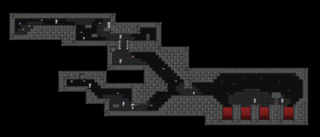
Although I later mastered the trick, at that time I could find no way to replicate the whip animation. Melee attacks are always tricky with this engine, even if you know what you’re doing. So instead — as with The McKenna Chronicles — I looked back to the stone-throwing of Dark Castle. It seemed a natural enough leap. This time I went for playability over cleverness, and had the stones fly straight until they hit something. I made the character jump a precise height and distance, and then developed levels around her. I made the levels short, and tried to introduce one new thing in each. I produced a final confrontation, and in a early version I included a Streets of Rage style text prompt that allowed for multiple endings.
And you know… the game wasn’t half-bad. Some glitches aside, it actually played well. It might have played better than any game I had made before. The character moved predictably, and the levels were made with some actual, practical thought. On top of that, the game was fairly attractive by my standards. Granted I couldn’t write the kind of soundtrack I wanted, the game was short, and the sprite wasn’t wholly original — but this was a pretty high water mark for me.

And then I decided to get clever after all, and I threaded the game with dumb, hidden smut. In my defense I was seventeen and I didn’t get out much. But this is where the game fell apart. Once I introduced that element, it was all that I focused on. I designed a complex branching structure to allow all of the hidden naughtiness, and then made a secret second ending for the player who managed to find and take every one of those left turns. And it was stupid, and it meant I couldn’t release the game. Not under my name. I couldn’t accept credit for it, and… shortly after I finished, I felt that I didn’t really want to, either.
I whipped up a new logo animation, and released the game for free, anonymously, under the “Really Weird Productions” banner. Then I promptly wiped it, and Game-Maker, from my memory. This was the end, for real.
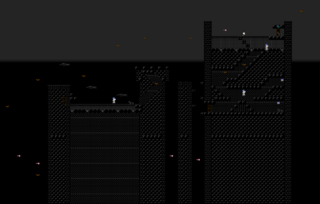
Thus ended my career as a game designer, at least for a while. My path started in dreams and sketches; notes on the margins of neglected homework assignments. Then I found a magical box, that promised me the world. Given the tools to follow through on those dreams, my ambitions soon compounded to outweigh my abilities, patience, and judgment.
At my core was a fundamental misunderstanding of game design. The point of design is not to get one over on the player. It’s not about competing with or bettering existing games. It’s not really about character or story or scenario, although they can help to make the point. The point isn’t about all of the cool features that I can cram into a game. It’s not about content. It’s not about a flashy presentation. It’s not about any of my a priori expectations, either about what a videogame is and should be, or about what I need to finish the job. The point is just to communicate an idea, as clearly as possible.
Game design is about looking at the boundaries available, and finding something interesting to explore — and then extrapolating it as far as it goes. It’s then about relating those ideas to the player through a careful dialog of rules and illustrations. Anything that doesn’t help to explain the premise is a distraction, and probably shouldn’t be there.
It took me forty games to get there, but finally, wordlessly, the pieces began to click into place. Of course by then I’d had enough. I was out of high school. I had other things to think about. Videogames had failed me and I had failed them. I was done. With a few exceptions I barely thought about them again, until the Sega Dreamcast.
Years later, I was a freelance writer. I mostly wrote about videogames, because that’s mostly what people expected from me. On one gig I was writing about indie games, and I needed an original topic. My mind turned to Game-Maker. When had I last thought of that? There was barely a word about it on the Web. So, I began to chip away. And it turned out, quirks aside, the tools were really well-designed. I wondered, were they good enough to make a contemporary game? One last game, I thought. One last try.

For a model, I looked to my previous finale. Again I drew a stick figure, and again I animated him with precision. Again I built simple levels around his movements and abilities. The more that I piled on the postmodern twists and weirdness, the more I felt the need to ground this new game in the past.
Builder was my follow-up to Beware the Gremlin! — not a narrative sequel; just its successor. I took what I felt I had done most right, and built on it. To make up for the added concepts I further stripped down the presentation, until the backgrounds were little more than flat colors. I don’t know if I was channeling Rod Humble or Berzerk (or, for that matter, Hero Core or Love+); I just knew that I didn’t want the presentation to distract from the design — and that the simpler the presentation, the more room it left for the player to fill in the blanks.
And you know, as creaky as that old engine was, with new eyes I found new life in it. Everything that was a barrier became just a property, to work with or around. All of these new ideas that I was exploring, I could have done this twenty years ago. I just couldn’t see that far in.
The limits to one’s art lie only in one’s head, and never in the tools at hand. The rougher the tools, the greater the discipline. The greater the discipline, the finer the expression. The finer the expression, the richer the art.
I may never be a great artist, but at least now I can use a simple tool. Maybe one day that will come in handy.
(Epilogue: In 2010, when I found my old games again, I took a long, hard look at Vampire. I was surprised. Strip out the idiocy, and there was a good game in there. So, I stripped out the idiocy. I tweaked a couple of rough spots. And far too late, I tacked on the original A-J Games logo. It is now a part of the canon.)
Four Decembers ago, while browsing Flickr I stumbled over a series of screens from a pair of previously unknown games, apparently designed with Recreational Software Designs’ Game-Maker. I contacted the account’s owner, and soon found myself in a fascinating discussion with Bionic Commando associate producer James W. Morris. The topic strayed from Game-Maker through a tour of the Shareware era, before fixing on the problems and potential of educational games.
This interview has sat on my shelf for over three years, waiting for formatting and a sympathetic host. Here I present in full James W. Morris, on learning to game and gaming to learn.
Here’s a little archive relic that I’ve tossed up on Gamasutra for the hell of it.
The Andy Stone interview went through several iterations, as it bounced from one publication to the next. When I reformatted it for Game Developer Magazine, I also threw together a couple of infoboxes to help with the layout of the piece. When GDM ceased publication the article fell through, and the sidebar text has since sat neglected in my article folder. Here I reproduce the compact version, to sit alongside the earlier Gamasutra Blog edition of the interview.
The decade between 1995 and 2005 was a dark time for the bedroom developer. With the introduction of the Web and the death of dial-up boards, the Shareware scene had crashed. With the introduction of 3D cards and the growing popularity of the home PC, development became complex and expensive. There was never a harder time for an amateur game designer to get started and build an audience.
That silent decade need not have happened. In 1991, a company called Recreational Software Designs released its own game design suite for MS-DOS. RSD’s Game-Maker supported VGA graphics, four-way scrolling, Sound Blaster music and effects, full-screen animations, large maps, and fully animated characters and monsters. Its editing tools were powerful and intuitive, allowing quick turnaround of sprites and background tiles and easy assembly into full games.
RSD ceased development just before the Web caught on, and right on the verge of a radical reinvention. The company never built an online presence, and Game-Maker failed to make much of an impression on the Web – leaving a big void for Mark Overmars to fill.
We caught up with lead programmer G. Andrew Stone, to talk about Game-Maker and the place that it holds in indie game history.
Just pointing this out to people. To celebrate the one-year anniversary of Alan Caudel’s current Dummy Duck strip, he has posted a new teaser trailer for his upcoming retro MS-DOS extravaganza Dummy Duck 7.
Yes, this is a Game-Maker game. Yes, the one by Recreational Software Designs. Hard to believe, huh!
I don’t totally understand everything in this either. Can’t wait!
Feel free to pass this on!
To catch up on the story to date, you can view the archive here.
So at sixteen I was a professional game artist. My work was still rough, but it was going somewhere. I had gained a little structure, a little ambition, and a huge mound of confidence. With guidance, these qualities can almost make high school bearable.
My period with Game-Maker began with what would have been my freshman year. At that time I was, if you recall, still dealing with old social ties. By junior year my life had stabilized a bit: I had adjusted to the school, and gathered a new wave of cohorts; I began to socialize more, and to spend time away from home. As I roamed, so too did my creativity. I began to write music, to learn to code, and to compose my papers in iambic pentameter. I may not have been brilliant, but I was uninhibited and I was curious.
I was also keen to show off. Whether or not I knew what I was doing, I had published six games. In the right social circle, that can go far — and this new crowd had no preconceptions.
Despite my recent crash course in discipline, I was still designing without a theory. Though my results had grown much more thoughtful and polished, and I had begun to stretch the technical and conceptual limits of my tools, to me a game was still about a character: one places a character in a scenario, then fleshes out the scenario using one’s knowledge of existing games and design tropes.
Add in a swollen head and new crowd of people to impress, and we have the renaissance of the insertion game.

There was a definite beginning. One of my associates was to spend his senior year in India. We had grown close since fall orientation, and had developed a pile of in-jokes together. I chose to give him a send-off, filled with all those jokes and hints of his own interests and personality — a fondness for martial arts, a blanket irreverence to cultural norms and sensitivities.
It helped that despite my knowledge of Tintin and Uncle Scrooge and an ostensible eleventh-grade education I had trouble separating my oriental stereotypes. Ninjas were from Asia, and so were snake charmers — and there was something in there about cattle worship. It was all part of the same pop culture muddle. Mind you, at this point I was in a prestigious private school. So I’m not sure what happened there.

With the prevalence of Ninja-based action games, I also had my choice of tropes and templates. Probably my favorite of Sega’s first-generation Genesis games was Revenge of Shinobi. Thanks to composer Yuzo Koshiro and the prominence of his name in the menus, this was also the game that made me understand that games were designed by specific people, each with his or her own voice, and that it was possible to follow an individual from one project to the next.
Revenge of Shinobi is one of those weird sequels, like The Adventure of Link. The original is a direct and merciless arcade action game, Sega’s response to Namco’s Rolling Thunder and one of many volleys between the two companies. As in Namco’s game you can flip up or down layers of a side-scrolling level. Instead of a spy, you play as a ninja. Instead of a gun, you have shuriken. In place of doors filled with ammo, there are scattered hostages. Touch one enemy and you die, but — uniquely to Sega’s game yet far from unique amongst Sega games — there is also a “ninja magic” button. It’s a panic button; press it, and everything around you dies.

The sequel takes advantage of its console origin by sprawling a bit. The character can now take several hits, and levels are less linear. There are now four types of ninja magic, that serve different practical purposes. The game is also filled with secrets and with weird unlicensed cultural references — some of which got Sega in some hot water when the original rights holders got wind.
More than structurally bold, the game is also gorgeous, distinctive, and varied — both visually and aurally. Although Koshiro only composed for this one chapter (plus a couple of Game Gear spin-offs), his music was so successful that his name is forever associated with the series. People just forget that he didn’t write all of the music. What’s all the stranger is that people sort of forget about Revenge. It’s the Shinobi game that was new when nobody had a Sega Genesis. It’s also the most elegant of the lot, and it was my starting point for Ninja Tuck.

I made the character was tall and thin, like Joe Musashi. I filled the early backgrounds with bamboo and secret tunnels. I even littered the starting screen with autumn leaves, that blew away after a moment. All was well, except that the tall character meshed awkwardly with Game-Maker’s limited monster sizes. Without getting really clever, the tallest enemies could only be half as tall as the character sprite. This was acceptable in some cases, as with the scattered cows and burning swords, but it got a little weird when I chose to include knee-high enemy ninjas.
I had the notion of building the game around short-range melee attacks, as in Ninja Gaiden. A problem that I had noticed in hindsight about Peach the Lobster was that the natural attack zone for a 40-pixel tall character tended to fly over the heads of 20-pixel ground-based monsters. Thus I drew from Joe Musashi’s powered-up melee weapon, crossed with Strider Hiryu’s Falchion — which is to say, a blade that is all swoosh and a swoosh that envelops all before the character.

Given that in RSD’s engine all attacks are achieved through monster birthing, there is not much leeway for preciousness. Melee attacks are hard enough when they’re a single, static monster block. A whole two-block sword swoosh takes some intense experimentation. Though in retrospect I can think of one or two better solutions, I eventually solved the problem with a single monster block that quickly shifts down as it animates. Good enough!
After the first couple of levels, my inspiration again shifted from Sega to Tecmo. Several of the later themes are inspired by either the first or the second NES Ninja Gaiden.

Finishing touches include a slightly pointless map screen informed by Commander Keen‘s overworld (itself informed by Super Mario Bros. 3) and a wealth of digitized sound effects. Most of these I recorded myself, and manipulated in Cool Edit. Some, such as the sound the apples make, were directly inspired by Adept Software’s little-known yet neato Zelda knock-off, God of Thunder. A few effects came later, when the object of this game’s tribute was available for recording.
As a final touch, I added morphing menus. As usual I teased the player with promises of a sequel, and even mocked up a few pictures to suggest what was in store for registered users. Maybe it was left-over ambition from my summer commission, but this time I followed through.

Often when I dropped in on my associate he would sing the refrain to a pop song that struck him as silly on some level. One of his favorite quotes was from Suzanne Vega’s “Luka“: “My name is Luka / I live on the second floor.” The way he sang it, I imagined Hervé Villechaize popping his head over the bannister to welcome a new tenant. Whether due to the accent or my own whimsy, I also misheard the name. Thus, continuing the series of in-jokes from our first game together, I named its sequel Ninja Tuck II: Booka.
Whereas my earlier insertion games were flimsy, half-hearted affairs, my work on Ninja Tuck had inspired me to new levels of ambition. Having established a basic framework, for my second go around I was determined to make everything as original and as flashy as I could. Thus aside from the sprite, I redesigned everything from the ground up. As in Peach the Lobster I designed all of the enemies around a common theme — in this case plants — and for consistency I drew all of the sprites and backgrounds in Deluxe Paint. I even dragged in Metamorf to animate some in-game elements.

Why I settled on the plant thing, I am unsure. To achieve it, I pulled on vague memories of all of my favorite botanical levels from the previous five years. Those included Sega’s Land of Illusion (the Game Gear sequel to the 8-bit port of Castle of Illusion), the Aquatic Ruin Zone from Sonic 2, and great swaths of Epic’s Jill of the Jungle. And then there were the monsters. It’s hard not to reference Piranha Plants, and the ones I had in mind were from Super Mario Bros. 3.

One of the later levels is based on a technique hit upon by James Faux of Eclypse Games, and used in his game Mortal Harvey. As an elevator rises, threats gradually present themselves; at the end of the ride, the floor opens up and the player moves on to the next level. In design terms, the level is all trickery. The player remains stationary, while the background animates; different columns of tiles shift at different speeds to create an illusion of parallax scrolling. Monsters slowly scroll down from above, to create the impression that the player is rising to meet them. My implementation was rather clumsy, but these sorts of levels do add variety.
James Faux also helped me to address that final bugbear of RSD’s engine, original music. For months I had been fussing with Amiga-styled music trackers, which consist of low-res digital samples keyed to MIDI data. Compared to the FM synth that Game-Maker supported, tracker music seemed like the way of the future. Furthermore, this stuff was easy to write. Thanks to the mid-’90s demoscene explosion, there was a free tracker for every UI flavor or song format one might like.
![]()
There were no obvious tools for RSD’s preferred format. I knew that someone had to be writing these .CMF files, as Epic Megagames used them for all of its early projects — Jill of the Jungle, Solar Winds, Brix. I was tempted to rip this music, which was as simple as looking for the correct headers and renaming the file extensions, but again I wanted to do something original. If I couldn’t, then to my mind it was better to keep using public domain material, even if it meant recycling the same pieces in every game I made.

For months I had been nagging RSD about better music support. I now know that there were complex plans on the board, but at the time my whining was met with silence. By the time of Booka, my petulance had reached a peak. With the aid of some awkward command line tools, James Faux and I were able to convert simple .MOD files to MIDI, and then to .CMF. It was a process of trial and error. Usually the result sounded like an angry modem. With a few tweaks, it might sound like an out-of-tune kazoo. Awful, but original!
Thus I scored my first game. Two or three tracks are by James Faux; the rest is all me, mostly to the game’s detriment. And yet, I was proud. Later I lopped off part of the intro music, adjusted its voicing, and turned it into the A-J Games theme.
After this experience I contacted RSD, and told them that I was “on strike” until they got the music situation in order. I wasn’t going to squander any more energy until I got the features that I wanted. Thus I rode out high school on small-scale games and half-baked experiments, waiting for a cue that never came. It would be years before I tackled and finished another game of this ambition.

Take Ricci’s Cow Hunt. I barely knew the fellow in the central role. He was a class clown; he liked cows; I worked from there. It began as a single level: character, item pickups, background. Whereas the sprites are Deluxe Paint beasts, the level is built from a small collection of simple bitmapped tiles. I drew them dot-by-dot in RSD’s Block Designer tool, then reskinned the first level of A-J’s Quest. The results were clean and bold, and stood out better than many of my gradient-fill blocks. Compared to, say, Crullo, this simple level looked and felt vibrant.
It’s not that I set out to be different; I set out to be lazy. I designed a character based on a slight acquaintance because I was bored, and I wasn’t about to invest the time and energy to build a real game around him — so I puttered in the easiest and quickest tools to hand. It just turned out that a lack of ambition equaled a decrease in affectation. I wound up concentrating more on the task at hand than the process that I had built up, and my basic sensibility took control.

So I had one level down, and it was kind of nice. Next step? Design another level — a completely different one, with a new tile set. Then another, and another. For over a year I continued to putter with Cow Hunt, adding new levels as the muse struck. When I had ideas for a new technique, I would pull up Block Designer, whip up a few tiles, then turn them into a level. Gradually the game became rather like an Ikea show floor; every level served to suggest a new way to mold and paint particleboard. There was nothing to the game besides touring from the entrance to the exit, but it was a pleasant journey.
I installed the game on the computers in the school lab. Whenever there was an update, I would make an announcement in the autoexec.bat files. I don’t think anyone really took care of those machines, as I got away with murder. As time passed I noticed unfamiliar names in the high score lists; it seemed that people were playing. With an apparent audience, my ambition grew. My levels grew more complex, with reversed control schemes and hidden passages. Thanks to this feedback I also realized the game’s object. There were few threats or serious obstacles, but it took a dedicated player to collect all of the cows. Every cow lent the player 100 points. Thus, the game was all about score.

How novel. Since Pac I had been trying to break or sidestep the engine’s location-based objective structure, and to backpedal to something more basic. Something pre-Miyamoto. Here it happened by accident, in a game that I hardly cared about, after I had given up on serious design.
Something else kind of happened. Since the game’s mechanics are so simple as to be almost nonexistent, the level design wound up pretty focused on the character’s abilities. Since the goal in any level was just to show off some new concepts before sending the player off to the next tile set, the design wound up focused more on exposition and forward momentum than on interrupting and frustrating the player. Cow Hunt is one of the first games I made where the player is free to poke around without judgment or severe consequence.

More than once I have heard the later, more confined levels compared to Mega Man. Although that series tends to typify judgment and severe consequence, I think I see what they meant. Peril or no peril, the clean bitmapped backgrounds and the forward momentum make Cow Hunt feel more like a real game than some of my greater efforts. There is a familiar sort of rhythm and flow, and the player feels prepared to handle every next beat as it comes.
I think on some level I noticed this rhythm, as late in the process I added the first level of Super Mario Bros. as a secret area (an area that would later form the basis of Jario!). There’s little to do here aside from run and hop to the exit, but I guess that was the idea. I think that I knew I was approaching something primal, or fundamental, about game design. What that was, I couldn’t have told you. I doubt I would even have described it that way. I just knew that things were working strangely well.

With a few new neurons buzzing, I decided to get deliberate again. I plucked a somewhat closer associate, in the shape of a former roommate with a shambolic persona and an affinity for R.E.M., and sketched out a grand plan.
Before I seriously ramped up production on The McKenna Chronicles, I settled on a rough story progression then blocked the progression out into levels. The initial scenario and structure were inspired by the zany historical fantasy of WolfTeam games like El Viento and Earnest Evans, crossed with a passing awareness of The Young Indiana Jones Chronicles.

The WolfTeam games are full of fast and quirky action, huge setpieces, and long scenes of interstitial exposition. Accordingly I gave the character a run function, precise Castlevania-style jumps, and a gimmicky, experimental means of attack; and I took advantage of Game-Maker’s new multimedia features to connect the dots between levels with elaborate cutscenes.
I think that, in the vein of Earnest Evans and Castlevania, I wanted to give the character a whip — which in principle would be a good follow-up challenge to the sword mechanic in Ninja Tuck. When I hit a wall, my brain slid laterally to Dark Castle, the crackly Castlevania-styled game for the classic Mac. In that game, the character slings rocks at airborne and ground-based rodents. Although I couldn’t replicate the precise mouse-driven aiming, I could add some realism by making the character lob his stones in a wide arc. Combined with the precisely measured jumps, I felt a mechanic like this would add some strategy and open up neat possibilities for level design.

The simplicity of Cow Hunt must have connected a few key synapses, as my whole approach to design had changed almost like magic. Previously my characters’ movement had always been vaguely defined, and their abilities slightly considered. If a character was to jump, his animation took him somewhere diagonally into the air. If he was to shoot, then at best the projectile might be matched to the animation. Since my command of the design was so hazy, I put only the most nominal thought into how a character would interact with its environment. So long as a task was possible, I was satisfied. “The player will figure it out,” I thought. Never mind that figuring it out often meant glitching the engine and relying on blind luck.
With Chronicles, that approach is no longer an option. The character jumps a precise distance up and over. If the character is to land on a platform, one needs to measure the distance between footholds. Too few tiles, and the character will sail over the target; too many, and he will fall short. Likewise the character’s default weapon has a specific arc to it with certain areas of effectiveness, and the character’s running momentum will only carry him so far if he should stop and slide.

So on a basic level the levels are mapped out according to the character’s abilities, in such a way as to regularly introduce new challenges and explore new uses of those abilities. On a broader level, the levels are also scattered with secret passages full of treasure — treasure that may be used to buy character upgrades, which generally allow the player to blaze through the game with less and less caution. The promise of these upgrades encourages exploration off of the most direct and obvious path through a level, and also gives reason to replay an area.
Even more broadly, Chronicles is one of the few games since A-J’s Quest that I extensively planned, as compared to charging ahead in a blind rush to the end. There was still a large element of improvisation; I don’t think the game’s full arc came into focus until I finished a draft of the first level. Even so, from very early on I had the entire game laid out as a series of labeled blanks. All I needed to do was procedurally fill them in, and the game would be finished. You can probably guess the punchline here.

Out of six planned levels, I worked on four and completed just two. It started off well enough. As with Cow Hunt, the active design began with a Deluxe Paint derived character and meticulously bitmapped backgrounds. In this case the monster and item sprites are also largely drawn in Block Designer. After the first level, the game took its own odd path through space ships, alien planets, and Monument Valley.
The second level, largely informed by Commander Keen, introduces themes of identity and deception. As in Sega’s Alien Storm, monsters begin to disguise themselves as items, background elements, and even as the player character. From here I built on the sprite morphing from Ninja Tuck II, supplementing the raw output of Metamorf with careful cleanup and bitmapped animation.

For later levels I imported textures from NASA photographs, and filled entire tile sets with large self-contained structures drawn in Deluxe Paint. I also drew and animated several full-screen cutscenes, frame-by-frame, and compiled them with some awkward command line tools into the preferred .FLI format.
And then… it was over. I think I told myself it was due to annoyance with lingering issues like the music situation. I wanted R.E.M. styled music, to reflect the fellow in the starring role. Though I had written music for Ninja Tuck II, the method was a headache to implement and the results were a headache to hear. I think maybe I was feeling fussy about control mapping and collision issues.

The real problem may have been in the planning. I may have overwhelmed myself, when I laid the whole game before me as a task that I obliged myself to fulfill. Or maybe, as with RÅdïp, I pulled a Hitchcock. Having planned the whole game in principle, the act of realizing it bored me. I knew where things were going, and my head just had to keep moving forward. Chugga chugga chug!
Whatever. It is clear that my patience with the game engine was wearing thin.

Case in point: my sole self-insertion game, Watch Me Die!. By my senior year, Game-Maker was more or less history. I had moved on to music, poetry, short stories, and illustration. Everything that in the past might have tied into game design was now set free.
I even co-edited the student literary magazine, Cereal. It consisted of bad poetry laid out in PageMaker then Xeroxed onto two or three sheets of legal paper. By my second or third issue I was irritating my co-editors by editing and designing the magazine alone. In my defense, it was nearly impossible to get them in the same room at the same time. Though I may have missed out on the spirit of collaboration, I still got the thing published.

For the purposes of Cereal, each editor had an abstract doodle as a portrait. One consisted of puffy hair, glasses, and a mouth. Another, a backwards baseball cap and some facial features. Mine was oval glasses, a nose, ears, eyebrows, and a few dangling strands of hair. This caricature formed the basis of the character in Watch Me Die!.
From the title on down, the game is a work of ironic apathy. I was creatively tired. I had stopped trying to be flashy or to impress anyone, and had returned to doodling in the vein of Ricci’s Cow Hunt. In the course of an hour or two I would knock out a tile set and a character, then piece together a couple of simple levels. In the case of this game, I made a point of my fatigue. In videogames the most basic measure of success or failure is life or death; even that was beyond my interest.

The character walks as slowly as possible, and looks frenzied while doing it. The idea was to instill a sense of futility. There is also a “skip” move that allows the player to speed up travel at the expense of some control. It is easy to skip over a ledge in one’s frustration with the pace of movement. The character also jumps very precisely and abruptly, with little fanfare. You want the character to cross a gap, or climb an obstacle? Fine. There, it’s done. Happy now? The lack of enthusiasm is almost droll.
There are items, and to contrast with the understated character motion they all overstate their importance. Simple pickups might be accompanied with a Hallelujah choir. Hearts can’t be simple heart shapes; they need to be big, throbbing organs. Again it’s all passive frustration with the design conventions and expectations that I felt no joy in rehashing.

Within all of this, something began to click. I was bored enough with the post-Miyamoto tropes that I had sort of transcended any rote obedience and begun to search for something, anything to interest me in the design process. What I came to focus on was the moment-by-moment interplay of the character with the environment. Everything else kind of fell away.
From the player’s perspective, Watch Me Die! is all about the controls. They’re simple, crisp, and accurate. The levels are built around the character’s abilities, not to do the player any favors but rather to see how well the player responds in a given situation. Death is easy, but if you die it’s because you screw up. And that’s fine. The game doesn’t dwell on the fact, so neither should you. Just start again from the top, and try not to die again.
It’s only when I gave up that my games began to feel right — less like the work of a fan desperate to replicate something that he loved, and more like a deliberate, professional product. Condense the control mapping so that all the jumping is on one key and the skipping on another, and you could stick Die in an arcade cabinet and it would almost make sense.
Everything good happens only as an afterthought, and so it was with my Game-Maker career. Some thirty-five games in, finally I made something playable — just in time for me to change tracks and leave all of my experience behind.
Or very nearly. In our final chapter we will see the results of design unchained. If you’re going to go out, you might as well go with a bang.
Next: Learning to let go.
To catch up on the story to date, you can view the archive here.
On reflection, I remember why I put RÅdïp aside. It’s because in the summer of 1994, I went professional.

My relationship with RSD goes back almost to the moment I received Game-Maker in fall of 1992. I soon finished my first game, and as solicited by a box insert I sent the game in for comment. After some awkwardness I struck up a rapport with the people behind Game-Maker and began a long correspondence. They would send me new builds and games from other users (some of which seem to now be the only surviving copies); I would offer bug reports and show them what I was up to.
Right off they ladled me with positive feedback and ignored any teenaged social awkwardness — something to which I was unaccustomed. They liked A-J’s Quest enough to release an early version with a slideshow demo of Game-Maker.
In the summer of 1994 RSD phoned me about a major revision to the software. Although there was still room for improvement, the update addressed many bugs and concerns and added enough features that a user’s games could feel almost self-contained. What’s more, the new Game-Maker would be on CD-ROM.

You may remember that before AOL watered down the concept, CDs were precious. To get a CD pressed was like getting a book published. CD-ROMs were new enough that every demo disc or shareware anthology felt important. Encyclopedias, medical guides, NASA photo archives — they all were tangible things, worth collecting. When someone said they were putting out a CD-ROM, it still meant something.
So that was nice; a big upgrade to my tools, published on CD-ROM. I offered my usual services, and RSD said they had a little more in mind. In 1994, 650 megs was enormous. To justify the disc, they needed to fill the space — so to drive up the value of the package, they wanted content. They wanted library sounds, images, tiles, sprites — and they wanted games. They meant to fill a shareware directory with user-designed games, but they also wanted their own sample material.
At first I didn’t quite understand what they were asking. I tensed up, and racked my brain for games that I could spare. I figured I wasn’t too attached to Cireneg’s Rings or Linear Volume, so I offered those. There was a pause. “Okay,” they said, “but we were hoping you could give us something… good.”

Slowly the lightbulb flickered to life. Oh; they wanted me to draft some original games. That was no problem. I could do that. We agreed on a deal for non-exclusive rights, and I got busy. Over the course of a month I designed six games, plus assorted content. For that, plus the use of Cireneg’s Rings and Linear Volume, they paid me a modest but fair fee — the first money that I ever earned.
Although any intelligent theory was still years away, this summer job was sort of a watershed for me as a designer. Whereas before I was simply puttering, this commission gave me the excuse to get serious. I made plans, I set goals, and I produced content on a schedule.
Nearly all the content that I designed, I designed for a reason. My first priority was to demonstrate Game-Maker’s abilities in the best possible light. To do that, I tried to fill in the cracks of the existing demo catalog. Each game would display a different genre or technique, both to show the software’s flexibility and to illustrate some design concepts for the user — both basic and advanced. This decision often meant challenging myself to try things that I had never considered, and would not otherwise have been motivated to explore.

For instance, my first submission was an experiment called Glubada Pond. Charitably you could call it a cross between Bubble Bobble and Ecco the Dolphin. At least, I think those were my points of reference. When I reverse engineer my thought process, I think the game developed from my problems with Pac.
Part of the idea of Pac was that I wanted to try something else besides the Miyamoto-fueled location-based sense of progression. Since Donkey Kong, and especially Super Mario Bros., the whole concept of videogame progression has been a matter of “I am here; I need to get there.” When you get there, the journey is over. When the journey is over, the story is over. When the story is over, you win. I’ve written about this before.

Although Miyamoto is deeply informed and influenced by Toru Iwatani’s work in Pac-Man, and indeed Pac-Man introduces a large element of exploration-based development — inasmuch as the player needs to explore every inch of the maze to call it done — Pac-Man works off of a simpler sort of win condition. Eat all of the pellets, and you move on. This is an evolution of earlier board-clearing conditions, dating back to Breakout but really entrenched, particularly in the Japanese industry, with Space Invaders.

I hadn’t thought all of this through; I just knew that with Pac I wanted to try something different and maybe more essential than I had been doing to that point. The results left me unsatisfied. The only way for success to hinge on clearing the scene rather than reaching a specific location was to block off the location with a door that would unlock if the player brought to it every item in the level. The problem here, aside from inelegance, is that there is no built-in way to reset the player’s counters upon death — and at the same time there is no way to retain the level’s status after the player’s death. So if the player dies, the character retains all of the benefits of having collected the items, yet the items are back in the environment to collect again. You can see the problem here.
Glubada Pond is, then, a second shot at the idea. Instead of Pac-Man, the progression is based on Bubble Bobble (which is itself closely based on Mario Bros., which in some ways is a throwback on Miyamoto’s part to the design of Pac-Man). More immediately I’m guessing I was inspired by Data East’s Tumblepop — one of my arcade staples at the time. Again I’m sure I didn’t think about it too deeply, but you can trace most hop-n-bop games back to Bubble Bobble and Bubble Bobble is the more iconic game to riff on. So that was probably my mind’s trajectory at the time.

You swim around and spit tiny bubbles at monsters; the monsters become trapped inside. Pop those bubbles, and they will leave super-dense bubbles. Collect enough of those, and you can open a treasure chest somewhere in the level. Collect the coins from that, and you can insert them in the coin-operated exit door. I’m sure I didn’t reason this sequence out ahead of time.
The player has the same problem/benefit as in Pac, in that it is easy to die and allow any collected bubbles to roll over. In this case I let it go. Although there is a complex system for restoring hit points, inspired by the bottled fairy business in Link to the Past, there are no extra lives — so if the player dies, any buffer bubbles serve as a consolation prize rather like the carry-over Options in Life Force or Gradius V. You may be dead, but at least you’re ahead. Speaking of which…

As I have mused, Game-Maker wasn’t made for shooters; the best attempts that I have seen only sort of work. My only previous attempt had been a clear failure, so at least I was devoid of false confidence. As it turns out, this may be the best starting point.
Whereas Nejillian Flux was basically a tribute to Konami’s Gradius, for Zark I looked to the Gradius spin-off and NES sequel Life Force. That, and Taito’s Darius II — or as I knew it from its Sega Genesis port, Sagaia. Maybe a bit of Natsume’s Abadox.

Zark came out better than its predecessor, largely because I broke down everything that I felt went wrong the first time. With Nejillian Flux I had no idea what I was getting into, so I dove head-on into design using the same techniques that I had for action-adventure games and platformers. When the engine failed to accommodate my whims, I butted heads with it until I lost and was forced to compromise — poorly. By comparison I planned Zark with full mind of Game-Maker’s limitations. This may be the first time that I employed such foresight, and I might not have had Nejillian Flux come out well.

One big change is with the weapon sequencing. In Nejillian Flux, the player could collect various power-ups that would give the ship new and varied abilities. Ostensibly stronger abilities replaced lower ones until the player was out of repetitions, at which point the weapon would default down a notch to the next most powerful weapon. This was fine, except that the weapons had no obvious sequence; as in Gradius each of the abilities served a different purpose. If the player picked up a flame weapon, yet the ship’s existing bubble weapon was arbitrarily ranked higher, then the player would only see the benefit of the flame weapon if the bubble weapon happened to run out of ammo.
It’s not a big deal, and it was the best that I could do with the checklist I had and the engine I was given, but this arrangement feels sloppy and unresponsive. From the player’s perspective, who is to say which weapon is objectively better — and why can’t the player just use the new weapon immediately? A lack of an immediate response also can make it unclear what exactly the power-ups do. By the time the player’s weapon defaults enough to make the new weapon viable, assuming that even happens, the player may not at all connect the ship’s weird new behavior to that power-up from a level or two before.

So let’s stop with the a priori and see what we can make of the materials at hand. If the only way to change or upgrade a character’s attack while retaining the same attack button is to design an attack hierarchy, then instead of tossing in any old weapon idea that I like, let’s make a proper hierarchy. For a rough model, I looked to Sagaia.
In place of the salad bar power-ups from Gradius, where the player collects arbitrary energy orbs to move a cursor from box to box and then selects a power when the correct box is highlighted, the Darius series has a linear upgrade path. Get a few red capsules, and your single shot turns to a double. Eventually you’re shooting simple beams and projectiles in all directions. There is never a real choice of weapon; there is simply a more powerful and elaborate firing state. Usually you attain it gradually; sometimes you can leap ahead a few notches.
Thus for Zark I designed a tiered weapon system. At its most powerful, the player’s ship fires in all directions at once. Each notch along the way is associated with a number; each number has its own associated item. Get a #2, and your weapon upgrades to level 2. Get a #4, and you leap up to level 4. Then pick up a #3, and — well, nothing happens. Why not? Because 4 is greater than 3, and you’re already at 4. It’s not a perfect solution; it’s not a bad one.

An even bigger area of improvement is the level design. There are at least three interesting developments here: the use of space, the use of tiles, and the use of colors. Of those, the most immediate and dramatic is the use of space.
To get around the issue of fixed and looping map dimensions, the levels branch off diagonally. Occasionally this means different routes to the same destination. When the levels remain linear, this creates substantially more space for scrolling — rather like that Mr. Wizard segment where the child cuts a hole in a sheet of typewriter paper, large enough to step through. So long as the ship keeps moving to the right, all the player need do is rock the ship up or down to account for the angled field.

While designing the organic-themed second level, which involves flying through the interior of an unknown monster, I hit on the notion of seamless barriers. By this I mean, rather than building an uneven tunnel out of discrete background tiles, to design an unbroken “skin” using at least twelve tiles (four flat surfaces, four diagonal surfaces, four “plugs” for where unlike surfaces join). Beyond the lit surface of the skin is darkness. Combined, the tiles can wrap around to trace any shape. For any special situation, special tiles can arise.
The effect of this design is a sense of elegance and polish. The screen is rid of visual clutter, and focused on the actual path ahead. The levels also feel more coherent; both deliberate and naturalistic. That sounds like a contradiction, but the sense is that things are where they need to be, and that anything unnecessary is absent or invisible. Compare the flood-lit grid of Super Mario Bros. to the shadows and highlights of Sunsoft’s Batman, and you see what I mean.

Even though Super Mario Bros. is the clearest possible example of elegant level design, its elements feel arbitrary. You have a collection of a half a dozen tiles, any of which might be moved a space or two in any direction. It’s almost like shuffling a deck of cards. You could design a card game around building Super Mario Bros. levels. It would only take a half an hour to nail down the rules.
The NES version of Batman feels largely of a piece. It seems to have its own geography; in place of distinct arrays are indivisible setpieces composed of big hunks of urban matter. It’s almost like a prototype for the arcade and Genesis versions of Capcom’s Strider.

All of the presentation in the world won’t make up for lousy level design, but atmosphere has as much of an effect on the player’s experience as the logic at hand. It’s all about focusing the mind where you want it to be and limiting opportunities for it to stray where you don’t. Usually that is a matter of verisimilitude, which is largely a matter of context: what behaviors make sense within the situation presented. If any individual tile may hold its own secrets, as in Zelda or Metroid, then that mystery and potential play into the moment-to-moment atmosphere and logic of the game. If the only thing that can matter is the route at hand, then it is visual overkill to do more than trace the outline of a boundary.
Something that I did learn and apply from Zelda, Metroid, and Mario is the effect of a simple change of color. In the 1980s and early ’90s, designers would regularly swap the palette to wring extra use from both enemy sprites and background tiles. The blue Octorok takes twice as long to kill as the red, and moves twice as fast. The brown, dried-out forest is more dangerous than the fresh, green one. You get to cram twice the variety into a game at a minimal cost of space, and give the sense of distinction or variety within an individual class of monster or terrain.
![]()
You know intuitively that different colors evoke and are associated with different moods. “Warm” colors — red, orange, yellow — make an image feel hotter, cozier, and more vibrant. “cool” colors — blue, indigo, violet — tend to evoke detachment, chilliness, isolation, and stillness. Green is a weird one, as it is technically a cool color but its implication can vary from calm and safety to disease and wrongness.
A curious case study here comes when you skin the same geometry with a different color set. A blue Octorok feels colder and more distant than a red one, therefore more threatening. Coming out of a maze of dead blue rocks, a golden tunnel feels almost magical; now the walls are bursting with light and life, and something important is bound to happen at any moment. You have broken on through to the other side, if you will.

These are the same tiles, the same rocks and joins and gargoyle faces. The only difference is the color, yet they have a totally different psychological affect, particularly in contrast with other color schemes. Although the primary reason for the palette swap is to save precious cartridge space, the consequence of seeing the same shapes in a new light is a sense of deeper understanding to their properties or to the change in narrative context that goes along with the swap in palette.
There is therefore value in designing an ambiguously variable palette: red can be cleanly swapped with green or whatever other color to change the game’s nuance from area to area, without need to create a whole new tile set. There is an elegance in minimalism, that is worth exploring before you start to add on extra junk.
So, level three is a palette swap of level two. In other news it is, I believe, here that I began to experiment with larger monsters. The thing is, Game-Maker’s engine and tools only allow monsters of exactly 20×20 pixels — and their behaviors are very simple. To make larger monsters means splitting the monsters across several 20×20 monsters that behave exactly in sync. If the player should kill one of the monsters, or perhaps a particular monster that is more susceptible, it then needs to emit some kind of “mop up” monster that can scoot around and kill all of the other monster parts.

My success here was limited. I littered the levels with large, moving background elements — and they were fine. They were also invincible, and fairly simple. At this point I had no idea how to approach bosses under these limitations, so they just amounted to large, static blobs of monster parts. Kill one, and an aimless explosion will swirl around to engulf the other monsters — occasionally missing a piece or even birthing an all-new cockpit or nose cone, due to a bug in the monster engine.
As I designed and submitted this material, the underlying software was in transition. Whereas I built the first games in an earlier stable version of Game-Maker, I built the final ones on increasingly stable versions of the new engine. Often RSD would go back and patch my earlier games, to bring them up to the level of the later ones. Some of those adjustments, like a couple of cutscenes added to Crullo: Adventures of a Donut, I only noticed fifteen years later.

Crullo is a curious one. It is here, I believe, that I began to go overboard with Deluxe Paint‘s gradient fills. I had developed a technique for drawing all of my sprites and background tiles in Dan Silva’s program, and had found the process both much faster and much easier than fiddling with RSD’s (generally well-made) Block Designer.
Deluxe Paint remains one of the best tools for editing low-res pixel art, and the most useful of its successors are basically enhanced ports or tributes for Windows. Its most heralded feature, rightly so, is its Brush feature — which basically allows the user to scoop up parts of an image, turn them into rubber stamps, and save them for later. When you add in the manipulation tools for those brushes, the ramifications of this feature are endless.
Less famous yet just as important is Deluxe Paint’s palette system, which is heavily slanted toward gradients. Establish colors A and B, twenty spots apart on the palette, then click a button to generate a smooth transition of twenty colors between them. You can then define and save this range as a gradient, and use it as you would a normal color, to paint, fill, spray, and whatever else. If you choose to fill, there are several powerful options as to how to distribute the gradient within the fill area.

If you know little about highlights and shadows and you’re a little bit lazy, it is easy to form a dependency on these fills. They look pretty good, and they only take a few clicks. They are also very distinctive; you can find their artifacts in nearly every VGA game, retail or Shareware, produced between 1989 and 1995.
Crullo was where I decided to use these fills for every visual element. I figured that to do so would make my games look professional — and it was so simple. Granted, the results were very consistent; it was clear that all of the elements had a common origin. In retrospect, they also look rather sloppy and generic — and at times so consistent that it can be hard to tell elements apart, for all the dithering.

As was my pattern, Crullo was derived from its character, a powdered doughnut with a jelly filling. Previously I had based a few games on inanimate objects. This particular doughnut began as a full-sized Deluxe Paint illustration that I shrank down and turned into a brush, and then later incorporated into an earlier game as a monster. It was a given that the game would incorporate monsters, and so it was a given that Crullo would need a way to attack the monsters. Thus, the addition of a jelly filling that Crullo could squirt out as a squid might squirt his ink.
As an aside, I was really confusing the doughnut situation. By no means was Crullo an actual cruller; more of a Hostess cake ring. Neither are these cake rings typically filled with jelly; jelly doughnuts tend to be a puff pastry with no center hole.

Anyway, because the protagonist was a doughnut I chose other baked goods for the antagonists — croissants, bagels, English muffins, water biscuits. As it was also a given that the game would contain item pick-ups, I filled the levels with Sonic-style rings of various colors; rings, because of the doughnut theme.
I dove right into videogame cliche by giving Crullo a missing girlfriend to rescue, and by sending him through a series of castles themed after the elements. I never really reflected the levels’ themes in their design; the only difference between a water level and a wood level is the appearance of the background tiles.
I also had not yet clicked on the idea of designing a tight control scheme for the character and then building levels around the character’s abilities. As with my earliest games, I figured that it was enough if it was technically possible to progress. The harder it was, the more I felt that I was getting something over on the player. Why I felt this was a good thing, and what I thought I was proving, I’m unsure.

While I was busy going pre-Photoshop crazy with the visuals, I also decided that the sound could use an impersonal touch. Whereas my earlier games had involved laboriously recorded and manipulated sound and voice effects, edited in a line of programs ending in Cool Edit Pro (the predecessor to Adobe Audition), I felt that it would be more professional to record sounds from a Radio Shack keyboard. RSD had asked for more musical effects, and clearly a game about a doughnut was the place for Casiotone.
The result is a disconcertingly cold soundscape, that feels incongruous with the game’s concept and the rest of the presentation. Between the lifeless, echoey sounds punctuating every action and the impersonal, mass produced levels that don’t even particularly acknowledge the character or its properties, Crullo feels a little eerie. Distant.
Despite this, the game seems popular in some circles. I keep getting hits from message boards in South America, and at least one fellow seems to use it as a test game for new ports of DOSBox. Again also, RSD saw fit to keep fiddling with the game and to include it with a demo of their software. I guess there must be something to it.

Before Crullo, I had already attempted ten other platformers. You would think with that experience I would have been on a roll. Instead, I think I just fell into a pattern too early. Even if my techniques were flawed, and I was coming at design from the wrong angle entirely, I thought I knew what I was doing and so I was designing on cruise control. Every shortcut that I could find to streamline the process, I would exploit as far as I felt like bothering. Spending too much time on a single project meant a delay until I could focus on something else, so there was always a rush to just finish things. The time for learning was over. With Crullo, the rush was all the more urgent. Here, for the first time, I had money to worry about. Money, and a schedule.
After three fairly ambitious, if short, games my energy was at an ebb — yet I had to keep going. For my next trick I would further explore the idea of palette swapping. The Patchwork Heart consists of four levels, three maps, three color schemes, and a big jumble of design concepts.

Really the idea was to see how much variety I could milk out of a minimum of minimally designed elements. The character is a simple golden sphere, shaded with Deluxe Paint’s gradient fill. Aside from the death sequence, I think there may be three frames of animation. All four levels use the same pool of background tiles. The monsters are all borrowed from Zark (so in turn I decided that Heart was an indirect sequel to or spin-off of the earlier game). The backgrounds are repetitive as hell, though they do employ some of the unbroken-line design of Zark.

Within these tight boundaries, I kind of went crazy. I am still unsure how I arrived at some of the design decisions. Although the character has barely any animation, when it moves it emits trailing monsters in the form of motion waves. These waves are as powerful as the character’s main beam attack, allowing some close proximity defense as well as some visual interest. Defeated enemies crumble into pools of blood; in a nod to Wolfenstein 3D, the player can then drink the blood to gain or recover life. Oh, and in case the player gets stuck there is a suicide key.

With a mind to both Theseus and the philosopher’s stone (perhaps as combined by Carl Barks), whenever the character touches a hard surface, the surface turns to gold. Initially this property merely seems curious; the player may be tempted to touch as many surfaces as possible, to make a mark on the world. In stage three, the power becomes more important.
The first two levels, and the fourth, are all traditional platformers. The first two are actually the exact same level, repeated with one weird and minor difference. At the end of the first level, the player is granted a super jump ability. The game makes no effort to signal this event. Halfway through the second level, the player has one opportunity to use the power. Miss it, or mess up, and the player is stuck forever. Succeed and continue on to the third level, which uses the same background elements to present a top-down maze. The character can move freely in all four directions.

Here’s where Theseus comes into play; given the Midas touch, the player can and most likely will mark every path along the way — thus turning the typical frustration of a maze level into a sort of a cathartic cleansing operation. There is no losing your way when you know everywhere that you’ve been.
Despite the minimal effort involved, I got very positive feedback to The Patchwork Heart — and I don’t just mean all of the weird Russian websites that pounced on the game. When I spoke to RSD on the phone, the CEO told me he liked the game more than Peach. At the time I had trouble believing that. Perhaps I should have listened, and taken a hard look at what I did right.

Peach the Lobster is a total opposite to the minimalism in Heart. This was my most ambitious game to date, and I was so proud of it. If The Patchwork Heart was one of those papers that you write at 2:00 AM on the due date, that mysteriously earns you a commendation from the professor, Peach is one of those masterpieces that you labor over for weeks and that lands with a relative thud.
To my thinking, RSD needed a mascot. It was 1994; what game company didn’t anthropomorphize its brand? RSD did okay with Penguin Pete and Smiling Savage Pete Pipeman, but I felt the need for something more dynamic — more like Sonic the Hedgehog. That, I decided, would be my penultimate game: the one to put RSD on the map.

This was going to be a serious, professional project; the centerpiece of my work for the CD-ROM. That meant employing Deluxe Paint to an extent that I never had before. Rather than hand-animating the character and monsters, I took a leaf from Wolf Team’s Earnest Evans and individually drew each limb and body section. Or, rather, I drew the outlines of body parts and then used the gradient fill tool to shade them. I then used Deluxe Paint’s brush rotation tools to assemble the parts into frames, and imported them into Game-Maker as sprite sets.

As pastiche goes, Peach was as literal as I could make it. I put the character in a track suit, because Sonic is all about running. All of the items are stored in computer monitors. The first world is similar to the Green Hill and Emerald Hill Zones; the second resembles the Labyrinth and Aquatic Ruin zones. The level intro slates are based on Sonic‘s Zone introductions. There are a few hints of Castle of Illusion and Altered Beast, but basically Peach is a Sonic clone that makes Jazz Jackrabbit look bold and original.

The game is focused through a blend of myopia and tunnel vision. I tried for visual consistency by overusing Deluxe Paint’s tools, but I failed to design the levels around the character’s animations — so often the player needs to glitch the game to proceed, or cannot possibly foresee an upcoming hazard.
I tried for clean animation by scientifically breaking down the sprites into segments, but I failed to think through what I was animating. All of the monsters are 20 pixels high or shorter, and Peach fires his weapon around 20 pixels from the ground — meaning that the player can rarely hit anything.
As in Zark there are a few multi-block monsters, but they are static and completely devoid of animation or meaningful player or level interaction. Their main virtue is that they happen to be large.

I did plan ahead to ensure that most of the enemies are ducks of some sort — but why ducks? The protagonist is a lobster. Why a lobster, for that matter? (And where are the rest of his legs?) What exactly was I doing, and why?
For all the time that I spent on wiring it together, Peach is a remarkably disjointed game. I was so focused on copying someone else’s game that I failed to mind whether that mission made sense with the tools at hand, and I paid even less mind to the shape and cohesion of the game that was actually developing as a result of my efforts. Peach is an inept copy because Game-Maker wasn’t made for a game like that; it is an incoherent game because I paid less attention to what I was doing than to what I wanted to achieve.
This wouldn’t be the last time I trusted technique and technology over my own artistic judgment; it is one of the more overwrought and under-thought examples. Regardless, it seemed to gain some traction in the MS-DOS canon. Peach is one of just a few Game-Maker games listed on Mobygames. So far as I know, it’s the only Game-Maker game used for official testing of DOSBox. In other circles, Peach is sort of an ironic meme.

The game must also have struck home with its publishers, as RSD soon refitted Peach with a new intro area and some slideshows, then distributed it as a playable demo for Game-Maker 3.0 — much as with A-J’s Quest, years earlier. This time, though the game itself became the demo.
I was unaware of these machinations. I just knew that the window was closing quickly, and that I wanted to finish up one more game before my deadline. A clean half-dozen; I felt that was respectable. I believe I asked them to wait for it; I had a simple idea, and I knew that I could finish it in a few days.

Clyde & Zeke is a game about two ducks. It consists of one map, a small tile set, a simple character, one enemy creature, two power-ups, and a gimmick creature — that being the second duck.
One of Game-Maker’s more confusing and least exploited features is its monster attack animations. Even the name is confusing. In this case a monster is any non-player sprite: a weapon, an NPC, a moving platform, or an actual adversary. Normally monsters can move at a set speed toward the character, away from the character, randomly, or along a set path. If the user defines a path, then along each leg of the path the monster can move at a different speed. Simple so far.
Each monster can also have a secondary behavior, that triggers in proximity to the character sprite; those behaviors can be relative to or independent of the sprite. When used well, this second move can greatly flesh out a monster’s behavior. It can make monsters responsive to the player’s actions, or ensure that beneficial monsters remain by the character’s side — almost like an extension to the character.

The problem is that this secondary movement is so hazy to define and hard to exploit. It is never clear how close the character must be to trigger the behavior, it is a matter of trial and error to establish the behavior in relation to a character, and it is not guaranteed that the behavior will always work as intended.
I lucked out with A-J’s Quest; my first game out, I gave the character a sidekick monster — and it worked pretty well. After that, I shied from the attack movements. They were frustrating, and I was intimidated. For my last demo game, then, I chose to demystify the feature. This game would be all about the monster attack movements — how to employ them in a game, and how to turn them into a deliberate game mechanic for the player’s benefit.

The player’s only attack or defense against the encroaching paper boats is his far more aggressive companion duck, Zeke. In theory the player should be able to circle and whip around to snap Zeke at the boats and destroy them. If the player isn’t careful, then Zeke may also eat the fish and bread slices before the player can get to them.
None of that really works. All that happens is that Zeke slowly follows Clyde, and then rapidly spins around on the spot. The player can defeat the boats by staying very still and allowing them to approach from the side. Most of the time, Zeke will destroy them before they can touch the player. Whether the mechanism that I imagined is feasible within Game-Maker, I don’t know. I just know that I couldn’t do it at the time, in the time that I had.
Regardless, I sent the game off. I understand that they received it; for whatever reason, it never made it into the CD. I think they paid me for it, though. Thus my first contract job ended on an awkward note. What else is new!

Some months later, the CD-ROM had yet to arrive. I knew the concept of lead time, but this was my first published work. Four months is an eternity. I began to obsess.
One night I dreamed, rather prosaically, that the package had arrived. I opened the package, and marveled at the CD inside. It had a cyan logo, in a curvy sans serif typeface, warped around the upper semicircle of the disc.
I woke from the dream and wandered downstairs to the front porch. There was a package for me. I opened it, and it was the new version of Game-Maker. The disc was exactly as in my dream, down to the new typeface, except that the lettering was orange instead of cyan.

I have a poor memory for color. If I actively know something, I’ll remember it; for passing memories, I tend to remember colors as their exact opposites across a color wheel. I remember red banners as green, blue signs as yellow, and of course orange as cyan. So, that’s sort of interesting.
That was almost the last that I heard from RSD. There were a few phone calls and letters, but the lead programmer and CEO was busy with school and other projects; within a year they abandoned support for Game-Maker altogether. I still played with their engine, though — first in hope of various feature upgrades, then absently, without ambition.
For all my bad habits and lack of insight, I was a different designer after this commission. Being forced to apply myself creatively at once drained me and encouraged me to think more efficiently about design. This was also probably the first time that I thought about creating for someone else, rather than just my own benefit. I had to keep in mind both the publisher’s needs, stated or otherwise, and the needs of the end user who would be dissecting my games for their own education.

The commitment also ensured that I saw each project to its conclusion. They may not all have been perfect, but I finished six games in a fairly short time — and some of them were as ambitious as I had ever tackled. Without that responsibility, the games would have lingered. Maybe a couple of them would have wound up better for the added time. I’m sure that Peach would never have gotten beyond the first level, if that far.
Most of all, this commission gave me confidence. This was the first time that anyone paid me for a service, and it was for my creative work. More than that, I had a published volume that I could wave around. To an extent I felt that all of my years of screwing around with my NES and Genesis were justified. All of the people who had mocked my comic strips and shrugged at my early games were irrelevant; this work had brought me somewhere.
I was high on my heels. I felt I could do anything. I knew the software inside and out. I felt appreciated, and a part of something important. This was the perfect time for me to show off.
To catch up on the story to date, you can view the archive here.
Did I say that things got better? Maybe eventually, but first we need to backtrack a bit. So far we’ve been looking at character games. Some of the characters are fictional; others are based on people I knew or who I didn’t know were fictional. Whatever the origin, these games are based more on objects than subjects. They didn’t start out as theories or experiments, or attempts to express a thought or feeling though the psychology of game design. Maybe in dropping these objects into the pond I drew some subjective ripples, but in principle my methods would have fit right in at THQ.

What we’re going to talk about now is another level of objective. You will have noticed my constant references to other people’s games — mostly professional, mostly derived from the Miyamoto-fed Japanese school.

It’s normal enough for one artist to look to another for inspiration; art is a form of communication, and nothing speaks to an artist like art. It’s also normal for a novice to model his or her work on something familiar. You can’t begin to speak your mind until you know the language, and you have some idea how to fit the pieces together to express ideas. An illustrator traces to get a sense of form; a musician may spend a lifetime interpreting other people’s music before he feels comfortable writing his own.

I guess what I’m doing is justifying creative laziness. I applaud the growth of new forms, and there will be a period of grasping before a form takes shape, but I always wonder why people will take an existing recording, loop it, and add a few riffs on top. If you drew inspiration from Abba or some Motown artist, great. Build on that. Then, erase your tracks.
There can only be so many Andy Warhols, making a statement about our perceptions and expectations of art. There is a place for collage and documentary, and cultural commentary. Generally, if someone is claiming a recognizable hunk of someone else’s work as his own, to me that speaks of a character flaw. It says that the derivative artist doesn’t give a shit about the original artist, about his or her own reputation, about the integrity of either the original or the derivative art, or about the intelligence of the intended audience.

Unless it is very well signaled I don’t really buy the tribute angle, and I have little patience for pastiche. I hate it when people quote from presumed authorities to make their own points in an argument. I cannot abide organized systems of belief or thought. If you can’t find your own thing to say, in your own words, I don’t want to hear from you.
So this chapter is about my own hypocrisy. I don’t know what parts to damn and what to excuse, so I’m laying out the whole problem now. I also have problems with absolute perspectives; as strict as I may sound, I know that nothing is ever that simple. There’s the principle, then there’s pragmatism. And sometimes to embrace the principle one has to spend a while fighting it.

Take piracy, in the modern lawyered-up creative sense. Is it wrong to copy someone’s work? Maybe; why are you copying it? And what’s the result? Did it do more harm, or more good? I think that copyright should expire after fifteen years, as you can’t control an idea once it gets into the DNA of public thought — but I also think that the original author should be able to enforce attribution. Organized chaos, if you will. Evolution with footnotes.

That doesn’t stop my own guilt when I indulge (as with the borrowed images in these posts), or temper my annoyance when someone builds on my work. I guess I should just get over it.
My least shameful tributes are those where I feel I built something original out of the borrowed material, however wholly I may have borrowed it. That isn’t to say that my divergence was deliberate. How much if art is really deliberate anyway? Anything that matters is usually an accident of technique or circumstance, and anything you try to do tends to end up obvious and meaningless. Why is that? Well, think about it. If you can’t even surprise yourself, how interesting do you think your ideas really are?
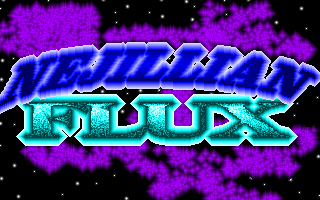
Nejillian Flux was supposed to be a carbon copy of Gradius, maybe with a bit of Life Force for variety. As it happens, RSD’s Game-Maker is a poor platform for scrolling shooters. They knew it, and improvements were on the radar, but they never quite happened. So I found some workarounds. Not good workarounds, but distinctive ones.
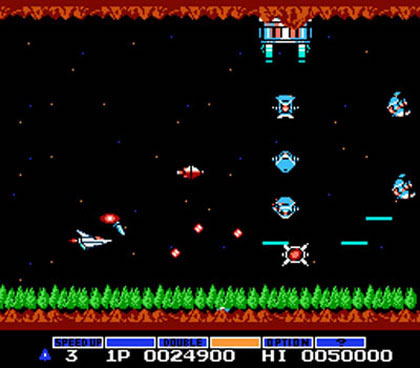
This was an early project. I can tell you how early because of an even earlier pastiche. When I was finishing up Linear Volume, I asked my client for a title. Linear Volume, he said; I went with it. I also mentioned my next project, a scrolling shooter based on Gradius. He told me to call it Nejillian Flux. It sounded good, so again I went with it.

To this point I had designed, I think, six games — three platformers, and three adventure-RPGs. Although I completed most of them, only one of those games — A-J’s Quest — had been very successful. I figured maybe it was time to try something new.
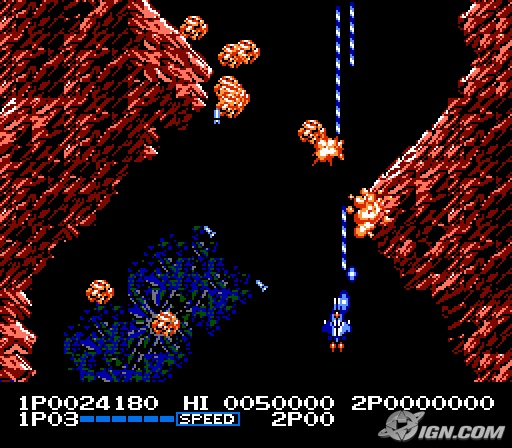
I hit three technical problems: scrolling, map size, and power-ups. The most fundamental of those is the scrolling, or rather the lack thereof. Game-Maker only supports a strange shifting-focus scrolling, where the camera always tries to place the character sprite 1/3 of the way from the opposite edge of the direction of the character’s motion. If the character is running right, the game wants to put 1/3 of the screen to the left of the sprite and 2/3 to the right. The same principle goes for all four cardinal directions, which in a game with free movement can cause the camera to lose all reason.
There are ways to work with this trait, but for a scrolling shooter it is fatal. The two common workarounds are to point the background gravity sideways, or to adjust the character motion so that it must always move in one direction. Neither really works, but if done well the player gets the general idea.

A related problem is in the engine’s strict map dimensions: exactly 100 pixels, square. That’s 6-1/4 by 10 screens, which may be fine for an overworld map. If you’re scrolling exclusively to the right, that means in less than 7 screens you will loop back to the start. Think of Eugene Jarvis’ Defender.
My solution was to double-decker the levels, and to hide a tunnel between the two stories. The player would keep looping until he or she found the passage, from which point the level became linear until the end. An eccentric choice, but it was the best I could think of at that time.

I also ran into problems with the weapon upgrades. The engine does not allow for arbitrary character or control states, so you can’t simply pick up a weapon and use it. The only solution is to give any weapon pickups a hierarchy, and to limit their ammunition. So if you pick up a very powerful weapon, you may only have 20 shots. When you have expended those, you default to the next most powerful weapon for which you have ammo. If you want to use one of the lesser weapons, then first you have to blow through the greater ones.

Then there is the question as to what makes a tougher power-up, as Game-Maker is very black and white about power levels. If your weapon has a level of 150 and the monster is at level 100, then the weapon kills the monster. If the monster has a power of 151, then the weapon does nothing. So weak weapons are pointless, and powerful weapons are perfect. If you’re creative you can find some lateral solutions; in 1993, I was not that creative.

Game-Maker’s engine was always a point of contention and curiosity. With a little lateral thought, it was capable of many things. Its odd and often simplistic arrangement resulted in dozens of unlisted features, and encouraged creative problem solving. Its comfort zone, though, lay in top-down action adventure games. It had the inventory and the four-way scrolling of a Zelda or Crystalis, and it was much happier when one avoided things like gravity or nuanced control schemes.

There are three ways of approaching a set of limitations. You can fight them, you can work within and around them, or you can subvert them. If you fight them, generally you will lose and your work will suffer. If you subvert them, you can produce very clever tricks to wow your peers who know what you’re up against — but chances are the tricks will be glitchy, and will fail to impress anyone else. If you work within the limits, maybe the walls won’t be so obvious and your work will be able to stand on its own merits.

Link vs. Gannon was my first go at working with the engine. This was maybe two or three games before Nejillian Flux. It was clear to me that neither platformers nor RPGs worked to Game-Maker’s strengths, so I relented. If the engine was geared toward Zelda, as it appeared to be, I figured I might as well see how close it could get.

The NES Zelda games are amongst my favorite things ever; the first for the actual moment-to-moment design, and the second for its weird atmosphere and its bold deviation from the original. I loved the claustrophobic focus, but I also loved that sweeping adventure too large to record in every detail — so I combined the design and dungeons from the first game and the free-roaming world of the second. Points of interest were scattered around a huge area, broken up by fields, rivers, hills, and bridges.
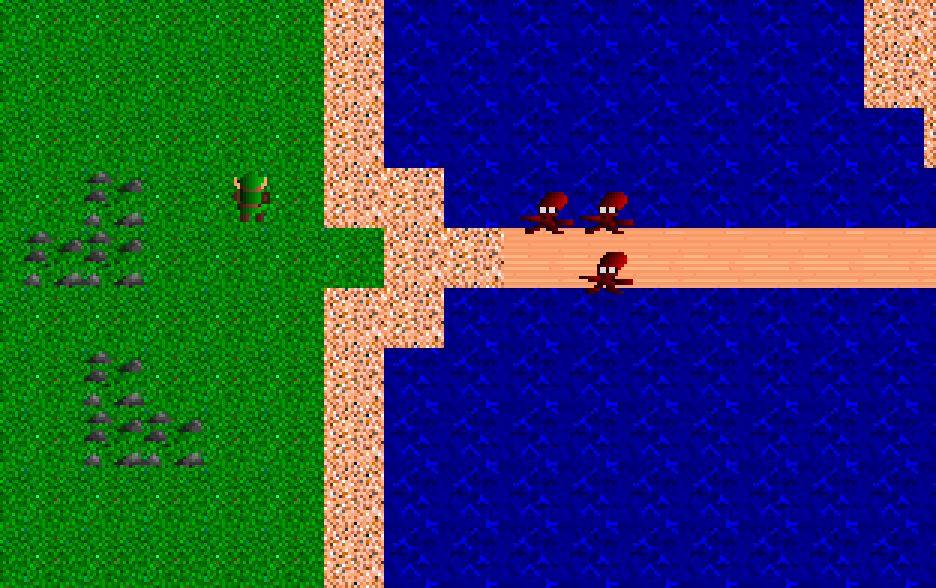
I doubt I meant to finish the game, and indeed Link vs. Gannon is the first that I left incomplete. I just wanted to figure out what the engine would handle well. The frustration came early on, when I realized that I was fighting far more than I had planned.
I often think of Game-Maker, if it just had X feature then it would be complete enough and I could work with all of the other problems. When I was in high school, I really needed a better music format. At other times I needed text boxes, or more detailed control mapping, or more complex enemy logic. On reflection, I think the sorest omission is the ability to make pervasive changes to the gameworld.

Here’s what I mean by that. In Game-Maker’s engine, the character can interact with the background — change blocks, pick up objects, kill monsters, and increase abstract counters linked with things like keys and locks. If the player dies or leaves a level, all changes to that level are reset — yet all counters remain as they were. So if you have a level that contains a precious item, you can pick up the item, leave, return, and pick it up again. If you kill a boss then return, the boss is back. And so on.
For a game like Zelda, that is all about exploring, discovering precious tools, and making slow significant changes to the world, it is disconcerting when nothing the player does can stick.

There is a way around this issue, but it involves a bunch of busywork and a tangle of logical wires that are very easy to lose track of. I also didn’t hit on the solution for a very long time. If I did, then evidently I never felt it was worth the effort. And that was my ultimate decision with Link vs. Gannon; it wasn’t worth the energy to figure out how to make it work, or to draw custom background tiles, or to put real work into the level design. I filed the game away, and for a while I continued with my own projects.

Over the years, the counter-and-flag issue kept raising its head. If I tried to do something complex, it was the lack of flags. If I tried to do something simple, it was the counters that wouldn’t reset. One of my more successful games, curiously enough, was a very hard Pac-Man clone. I asked that anyone who enjoyed the game simply send me a postcard, saying “I like Pac!” I got maybe half a dozen cards over the years. Nejillian Flux also traveled a bit. For a while it seemed I couldn’t browse a shovelware CD or Russian shareware site without stumbling over the game.

The problems with Pac were twofold. First, there was no way to contrive it so that power pellets made the character immune to the enemies’ touch. I got around that by turning the pellets into projectiles that the character could spit out. More worrisome is that if the player died before eating all the dots, the counter would carry over but the background would not. In retrospect I’m sure I could have contrived a way to drain the counter at the start of a new life, but the solution I found was to give the player only a single life. One life, one hit point. To reach the end, you have to play a perfect game. Not the most elegant solution.

If it wasn’t the flags and counters, it was a lack of arbitrary character logic. Pac can’t eat ghosts, and Mario can’t stomp enemies. For kicks, one of my later projects involved transcribing the background tiles from Super Mario Bros. and the sprites from Super Mario 3, almost pixel for pixel out of a magazine, in attempt to find some way around the stomping issue.

Even more so than Link vs. Gannon, Jario! is barely a game. I didn’t bother to animate the sprites or design a real level; my whole concern was with trying to force an issue on which the engine wouldn’t bend. It was just as well; I never much liked Mario anyway.
So most of my tributes were a bust. That can be a problem when you have a fixed idea of what you want to do. When you follow the tides of intuition, things tend to just work. You take what comes and you look for something unusual to build on. When you’ve a specific goal and method in mind, anything can trip you up — and since that’s not where your head is you won’t be prepared to roll with the problems and compromise. As time went on I softened in my preconceptions as to what I wanted from a game, as to what a game was, and as to how to achieve that.

About thirteen years after my last Game-Maker project, I unearthed the software as part of a series for an indie game blog. I was surprised how good the design tools still were. If anything, they were more fun to use than most of the games they produced — clear, intuitive, instantly rewarding. I knew the engine’s limits, and I was curious how well it would serve to make a contemporary indie game. In my articles I had mentioned the engine’s strengths; as a test, I chose to replicate The Legend of Zelda as exactly as possible.

I ripped the original sprites and background tiles, then enlarged them by 25% in Photoshop to fit Game-Maker’s standard. It turned out that despite the difference in scale one Game-Maker screen had the same number of tiles as an NES screen — so I recreated the maps as closely as I could, block by block. I found tricks to allow Link to burn bushes and touch an Armos to bring it to life (and maybe find a secret passage). I gave the Octorocks complex behaviors and allowed the Leevers to burrow, immune to the player’s protests.

The only real problem remaining with Overworld was the counter/flag issue. I used a web of level nodes to ensure that Link would only find the wooden sword the first time into the cave, but I knew that after just a few choices the game would soon get much too complex to keep track of that way.

I stopped after filling the world map; I figured I made my point. The dimensions are different from the original Zelda overworld — taller, narrower, and a little smaller overall — so I made do, compressing some locations and expanding or moving others. I figured if I ever continued with the game I could split the overworld across two maps; maybe connect them with bridges across a river.
Although the game was never a serious effort, and indeed took no more than a few hours from me, my mind began to swim with the new techniques I found while bending and cajoling RSD’s engine — the screen-by-screen level design; the complex monster behaviors; the constrained color palette; multi-stage attacks; new monster birthing techniques; and in particular, using monster counter-buffers to alter the level geometry. Those techniques, and their very buggy repercussions, would become the basis for Builder, my first new Game-Maker game in half a lifetime.

Builder was a web of secrets, accessible only to a player who surrendered to and explored the engine’s glitches. A big part of the design involved ensuring that the game’s secrets remained secret until the player hit the right triggers, which on the lowest level I controlled with level nodes and paths. Finally a Game-Maker game responded meaningfully to the player’s actions, and in the most profound sense it did it behind the scenes.
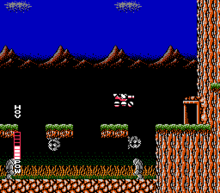
Between these new tricks and my success with Builder, I was ripe with enthusiasm. It had been ages since I had worked on any game, never mind this old engine. I had the notion that I would pull out all my old unfinished Game-Maker games (nine, including Overworld) and wrap them up with style. I would put a cap on that whole thread of my life. No one would ever play them or care, but I would feel a sense of closure.
After perusing then discarding the obvious candidates (The Return of A-J, Sign of the Hedgehog 2) I turned to the best of my tributes, one that had lain neglected since 1994. RÅdïp was the unripe fruit of a competition with another Game-Maker user, a fellow whom I had met through a long distance dial-up board. Both he and I set about designing Blaster Master tributes; his was nearly as literal as Overworld, and my game took on a life of its own.
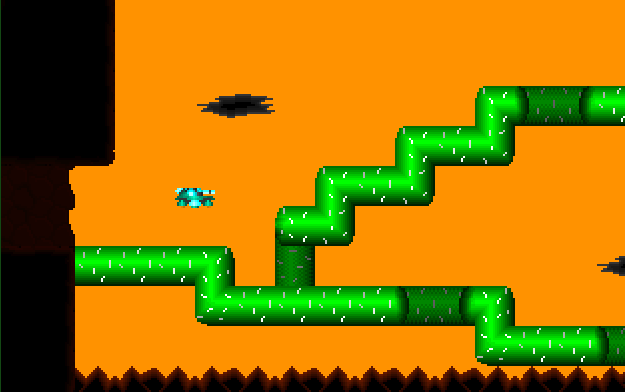
The vehicle looked similar to the one in Blaster Master, and on paper it had similar abilities — and the background tiles in the first level were similar to the tiles in one room of Blaster Master‘s final level. My vehicle controlled very differently, though — indeed better than nearly any pre-Builder character. The moves and attacks all had their own interesting flavor. The monsters were original and memorable. The level design needed work, but it involved some big, brave ideas. The game had spirit. I wondered why I ever put the game aside; it wasn’t much, but it was good.
It was also fully planned. Maybe I’d just had an Alfred Hitchcock moment and grown bored the moment I knew how the game would pan out. I had blocked the whole thing out — all of the levels, all of the bosses, the environments, the upgrade sequence, and the web connecting it all. All the game lacked was content and polish. So, slowly I added content and I polished it. Maybe I’m still doing it. I haven’t touched the game in months. Right now it just needs a final level, a transition level, and five or six bosses. I also need to complete a water level. I’d say it’s 80% done. I think I’ve just had other things on my mind.
The real trick to RÅdïp is its structure. It’s a free-roaming action-adventure; you beat bosses, earn upgrades, and revisit old areas to climb that wall or destroy that barrier with your new powers. This means affecting your environment, which means setting flags, which Game-Maker won’t abide without a headache.

Well, I survived the headache. The game has only a few items to account and maybe 18 unique areas, but it needs 80 nodes to track the changes and who knows how many links to hold it all together. If I weren’t intent on copying someone else’s idea of a game structure, I wouldn’t have bothered — but I did, and it works.
I’m building up to a point here. Hang with me.
Continuity notes:
After Nejillian Flux, The next game I designed was Explorer Jacko — you remember, the insertion game with all of the Star Control and Trek references. The ship that Jacko steals, early on? Why, the Nejillian Flux of course.
Also, some of the elements in Link vs. Gannon would later be incorporated into Linear Volume and Explorer Jacko. This is why in effect you will see Tektites bouncing around the fields of Motavia.
The story continues in Part Eight…
Another AdLib track. This one has lyrics, as yet incomplete. It came to me, you see, when I found myself repeating a phrase to myself as I went about my housework. One has little control over these things.
So. There you go. If I finish the lyrics, I may post them. Or not!
I have been toying with AdLib Visual Composer, a 1987 tool from the makers of the AdLib sound card, the first widely supported sound card for the IBM-compatible home PC. The Ad Lib had a Yamaha OPL2 sound chip, an FM synthesizer roughly similar to the OPN2 chip in the Sega Genesis. FM Synthesis has a distinctive sort of metallic, twangy sound to it. If you’re looking to replicate a real-life instrument you’re probably out of luck, but if used sensitively (for instance by Sega composer Yuzo Koshiro) one of these chips becomes an instrument in itself.
As I wrote earlier, Dan Froelich did a splendid job with the FM chip grandfathered into Creative’s Sound Blaster cards. His work was long my mental benchmark for PC-based game music. Earlier this month I visited his site and learned what he used all those decades ago. I then sent him a hello-and-thank-you note, and went to exploring the software.
It’s pretty easy to use, if you have a head for turn-of-the-’90s DOS programs. It lacks some obvious features like Undo, or the ability to automatically stretch or compress notes. It does support now-standard hotkeys like CTRL-X and CTRL-V, and even the Shift-click selection that some modern sound programs mysteriously lack. It really comes off like a Deluxe Paint for sound, complete with the odd native file format and blanket industry support.
Indeed Visual Composer was so widely used that I wonder why I only heard of it recently — especially since for 20 years I was actively looking for something like it. Now that I know of it, I seem to be tripping over references to it.
Here are some of my early experiments with the program. Mind you, I’m hardly Béla Bartók. I’m also unsure that I’ve learned all of the program’s facets. Still, I rather like the results so far.
(Now updated with higher resolution recordings, plus one new track.)
To catch up on the story to date, you can view the archive here.
Here I hesitate. It would be easy to skip this next wave, and I am tempted. Posterity beckons, however, and I am resigned to meet it halfway.
In a sense these are all insertion games, or are derived from previous insertion games — but the characters that they insert are fictitious. They’re all avatars, removed from their original context.
Also removed from context is much of the games’ content. In assembling these games I repurposed hunks of earlier projects, either to avoid losing material that I had cut or to sculpt dioramas of my own adolescent interests. Though I roll my eyes at projects like Tony & Me and Operation Killbot, I was not immune to that mentality.
If anything, I may have been worse. I felt weird about distributing those games as they were, so I snipped out the most foolish bits — and then I kept those for myself, to indulge my own objectives. This was even weirder for me, so if I chose to distribute the games — as I often felt compelled to — I did it under a series of pseudonyms.
It all started with a practical joke.

Around the turn of the ’90s, to be in tune with videogames meant being a fan. Between third and ninth grades, I loved videogames — incautiously, without judgment or analysis. Some games grabbed me more than others. The games that didn’t, I figured I was just too young to understand them. Bugs, glitches, and bad design struck me not as flaws but as figments of scary, unpredictable realities that I was not prepared to handle.
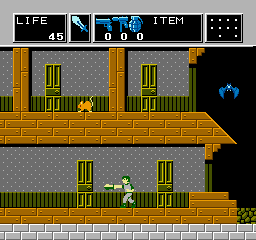
I think that perception comes out of my approach to videogames. For me they have always been about exploring the unknown; playing with new concepts and following them to their logical extremes. When those extremes take me places that I would not have imagined without that structure, I feel wonder. When something breaks that structure, I feel a stab of cognitive dissonance that offers a window to a greater world view. As wonderful as the structure may be, the idea that there’s something beyond it, that I am not yet in a place to understand, gives me a certain awe. So, I was really into games like Zelda, Metroid — and eventually things like the Game Genie.

When they began to appear, game magazines fed into the mystique, suggesting unknowable depths and hints of what was to come, both within an individual game and within the medium as a whole. The magazines were a way in, and the best outlets made a person feel like there was a real conversation going on. I wasn’t just bashing my head on these worlds and forming my own opinions; I had a few hints at what their authors intended, or what I should be looking for. I could then better focus on the games, and better understand what they had to say. I knew that there was always more to know, more to find just beneath the surface.

I read whatever magazines I could find. There were only so many at the time. I subscribed to Nintendo Power, and enjoyed the early issues. Heck, I subscribed even before it was Nintendo Power. Even before the newsletter became a glossy magazine! It was just pinkish folded-over paper stock. GamePro was sort of the standard, so I read that. When I could find it, I puzzled over VideoGames & Computer Entertainment. That one was often a little headier, and it covered many topics that I didn’t understand. Its back pages were also where I saw my first ad for RSD’s Game-Maker.

As an adolescent, the magazine that struck the best balance for me was EGM. I don’t remember why I so enjoyed it. I think the Review Crew may have had something to do with it. By that time, games were coming out rapidly for several systems. It was getting hard to keep up with everything. To cover as much ground as possible, three of the magazine’s editors and one fictional character would offer short blurbs about each game. Although they never commented in much depth, the blurbs were lined up in columns so you could cross-compare their responses.
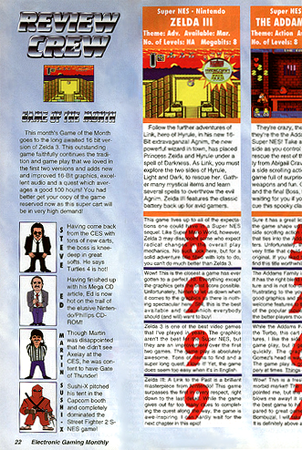
In retrospect the format was not only lazy; it was lifted wholesale from Famitsu, the Japanese magazine that Western gamers held as a gold standard until people began to translate the reviews and realized they had nothing interesting to say — and that what little they did say was bought by the game publishers. At the time, though, it just added to the sense of an ongoing conversation. I was fascinated that the writers all had contrasting views to offer on each game that came along. This probably lined up with my sense at the time that there were no bad games; just games that weren’t made for me.

The most intriguing of those writers was of course the fictional one, a mysterious fellow named Sushi-X. He dressed like our cultural consciousness of a ninja and obsessed over tournament fighting games. In reality he was a placeholder for whatever intern wanted to contribute an opinion or whatever editor wanted to speak anonymously. That would not become clear for another decade or so. In the early ’90s, Sushi-X was the coolest dude in the coolest band of game journalists. Which is to say, a boy’s club that set the stage for twenty years of stunted and exclusionary gamer culture. But hey, adolescents look up to big kids.
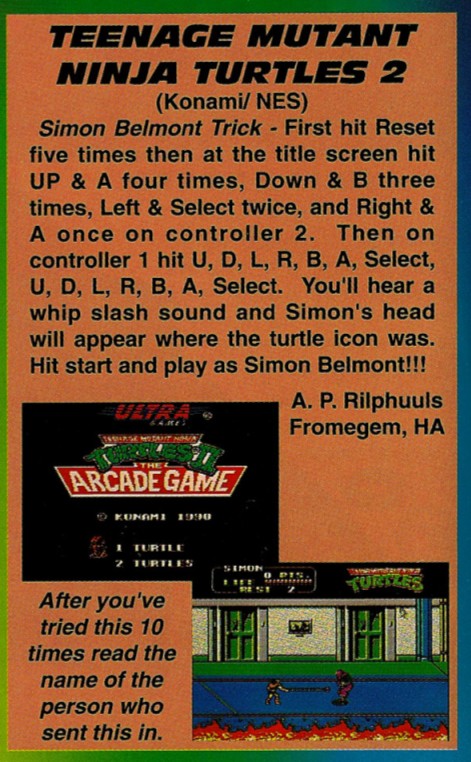
One of the club’s more memorable shows of adolescence was its yearly April Fools pranks. In 1991 they insisted that with the right code you could call forth Castlevania III‘s protagonist into Teenage Mutant Ninja Turtles II. It sounded plausible, as both games were by Konami, and it played into that vague sense that anything could be out there. The following year brought the Sheng Long prank, which was reported as fact worldwide, and in changing people’s expectations for arbitrary nonsense changed the way that fighting games were designed and perceived.

By 1993 I had a good three months of experience with Game-Maker, so I felt ready to play my own prank on EGM. I borrowed resources from A-J’s Quest, drew approximations of EGM’s Review Crew avatars, and sent Sushi-X on a quest to locate a fabled Street Fighter II arcade cabinet. Along the way he faced the logos of competing magazines, and could regain energy by picking up issues of EGM. I credited the game to Sega, and sent it in anonymously with plenty of lead time for the April issue, to see how they would react.

They didn’t. Fair enough. The game was kind of terrible anyway. The best part was probably the sound clips. The monsters had an entertaining death noise, and whenever Sushi-X found an issue of his parent magazine he would sing the praises of his publication. I quickly forgot about the game, only to unearth it when looking for material to scavenge in the assembly of Tony & Me and Operation Killbot.

A few of the background tiles also made their way into Sign of the Hedgehog, which perhaps justifies this prank a little further. Also as my second attempt at a platformer, Sushi-X Breaks Loose probably taught me a pile of lessons in what not to do. I don’t believe that I repeated my mistakes here.
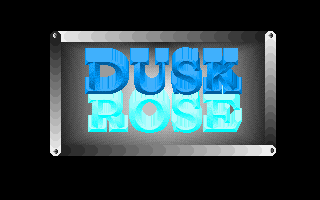
The negative lessons continued with Dusk Rose, a game based around an early Dungeons & Dragons character.

My history with D&D began in eighth grade. The way my associates pitched it to me, a person could make any kind of avatar he wanted; give the character whatever history and personality and talents one desired. In absence of ready game design tools, the notion fired my imagination. I sketched characters; I wrote ornate backstories; I developed quirks and abilities to set them all apart and open up play potential. Mark — you remember, from Operation Killbot — appreciated none of this.

Somehow Mark declared himself Dungeon Master for every campaign. If people planned a game without him, he would flip out. I remember an instance where he screamed at someone for buying a Dungeon Master’s Guide, because only Mark was supposed to know all the rules. Authority was everything to this guy. If a player diverged from the letter of TSR’s guidelines, or failed to take the campaign seriously enough, Mark would turn strawberry red. Often he would kill the player’s character right there, out of spite. He would then take the character sheet and refuse to return it. In time role-playing with Mark (and there was no role-playing without Mark) became a matter of gaming Mark’s temper; setting up situations to draw out and maximize his anger, so that the players could all watch him fume. By tenth grade we got pretty creative.

I believe my first AD&D character, after I graduated up from the basic rules, was a half-Elven thief named Dusk Rose. Although I remember little of it, I put especial work into her character. On her first day out, I failed to adequately respond to Mark’s cues so he killed her. He then took from me the character sheet and supplemental material, rendering all of that work moot.
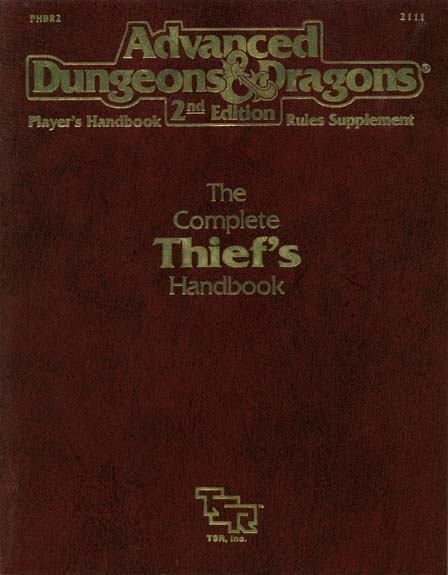
With Game-Maker, I felt she had a second chance. I figured if I could adapt a few basic rules, then I could allow my character the life that she was denied on paper. The first and most basic test was the AD&D thief skills: hiding in shadows, picking locks, moving silently, disarming traps, climbing walls — you know, all the stuff that Looking Glass explored five years later.

None of it worked. For some failures you can blame my technique. To make Dusk Rose hide in shadows, I colored her shades of black and dark gray, and had her perch in the background. That was silly for a bunch of reasons. Later I perfected the idea in A-J 3; there, you can hold the space bar to turn a certain character invisible.
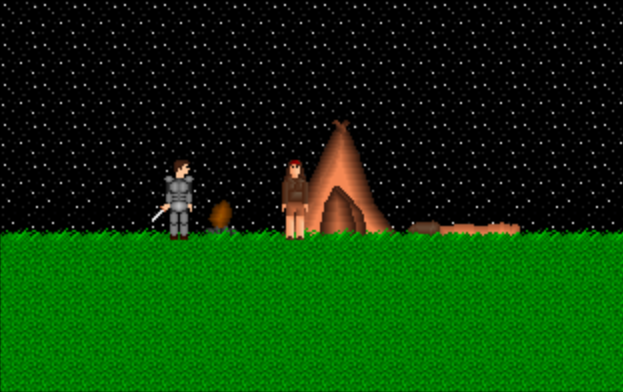
Other failures are more about the engine’s limits. There are several ways to implement wall-climbing, but all have their downsides, and none work quite as I wanted here.
I was also intent on including adult material, to reflect my detailed imaginings of the character. To hide the material, I imagined and partially designed some branching paths. If the player made certain anarchic choices, he could stumble into some bawdy situations. Otherwise, the game would continue without a suggestion of what lay beneath. Although I later removed these elements, the branches and parallel paths were an early hint of the techniques I would later use in games like A-J 3 and RÅdïp.

Given the common origin, Dusk Rose became a spin-off of Cireneg’s Rings. Although I never finished the game, it does serve to flesh out the game world.
That world is even further fleshed out in Dungeon Erghuck, a game of many sources and a source of much embarrassment.
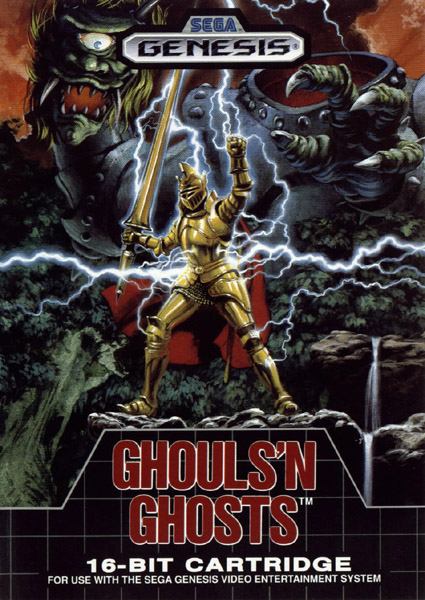
Back when game magazines came with photographic maps and reviews amounted to a few quips about graphics, the best source for detailed and up-to-date information was a game’s own packaging. The box art evoked a mood and a theme. The template made the game feel like a part of a collection. The warped screenshots and back-of-the-box copy spun the game as a whole world to explore and marvel over.
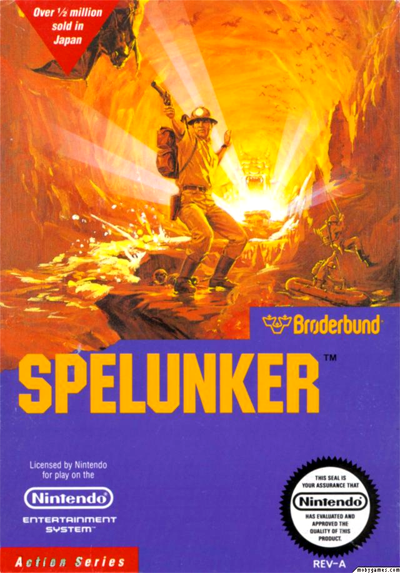
Selecting a game was a matter of standing to the side of the register at Kay-Bee Toys and peering at the racks of box fronts. When one caught your eye — either a new game or one you might have pored over a dozen times already — you asked the clerk, and she would pass you the game. The shrink wrap gave the cardboard (or clamshell case, if we’re talking Sega) a sheen and a certain smell. There was a whole world in there.

You would stare at the painting on the front, and try to extrapolate the action and experience of playing. With that in mind you would flip the box and animate the screenshots in your head. What were those creatures? What was just off the edge of the screen? What was the character doing, exactly? The text below would offer context and promises.
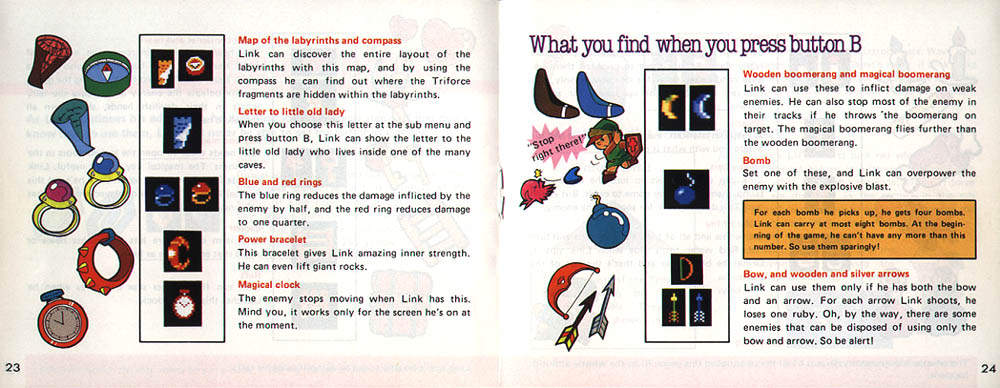
If the box churned up just the right image, and your parents were amenable, it would go under the scanner and into a paper bag. In the back seat of your parents’ car you would strip away the cellophane, pull out the instructions, and memorize them. The notes and sketches would kindle the imagination, as it worked to sketch out the whole game before you even played it. The odor of the packing material would drift out, rousing some center of your mind with the reality of something new and marvelous at hand.
So it is that one trains one’s self to derive huge and nuanced concepts from just a few shreds of information, and sets a game up for wonder before even hitting the first glitch or passageway.
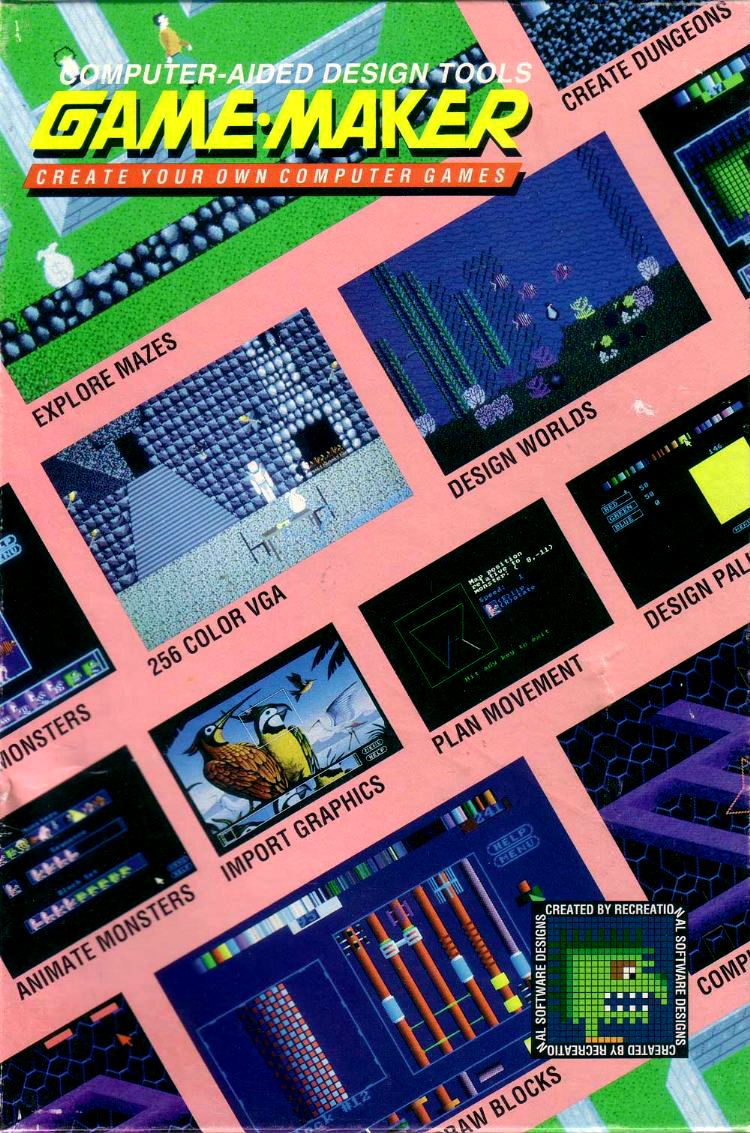
For me, Game-Maker was a birthday present — one that arrived early. I was allowed to hold the box, and look at it; I just wasn’t allowed to open it or install it on my father’s 286 until I turned 14. For weeks until then, I was entranced with the screens strewn across the box front. It’s like they were trying to kill me with sheer potential. The back of the box gave no hint at limits; only the possibilities that the tools provided. I had no clue where to stop imagining.
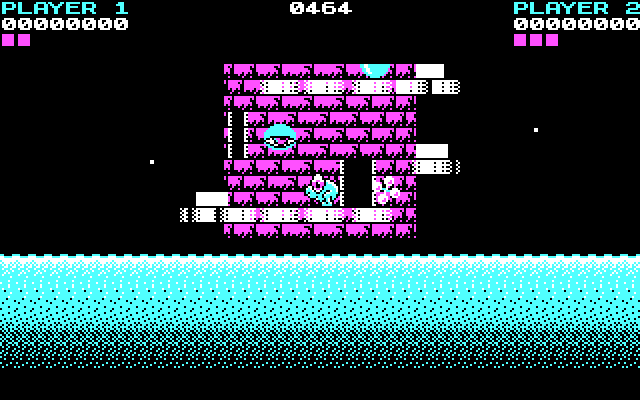
Without context, I filtered the screenshots through my knowledge of PC games and tried to find broad matches. My knowledge was largely informed by a disk passed to me anonymously, I think originating in Russia. Those disks were crammed with mostly very old CGA DOS games like Alley Cat and Jumpman. I took Pipemare‘s tile set as an experimental climbing game like Tower Toppler. Another game (as I recently learned, the first experiment by RSD president G. Oliver Stone) reminded me of the box to Deadly Towers, an NES game I had never played but often studied in the mall.
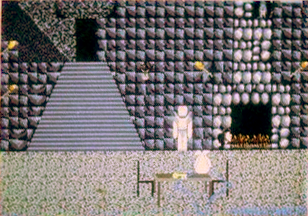
As it happened, the box included no such game. Also, Game-Maker was not built for such oddball games as Tower Toppler or Alley Cat. Yet these images persisted, mingled with the haunting memory of that Russian disk. When I reached a certain comfort with the tools, I set to reconstructing RSD’s dungeon game according to my ideas of how it might have been.
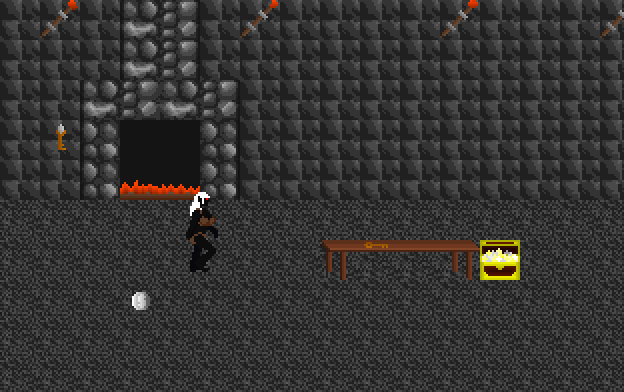
Around that time I began to think better of the bawdy extras in games like Cireneg’s Rings, Tony & Me, and Dusk Rose. The problem with deleting it from the parent games is that I felt I had to put this content somewhere. I throw nothing away. Somehow, then, it made sense to dump all of the crude pixelated smut into the dungeon levels. They were vacant, and a borrowed idea anyway.

In its earliest form, then, Erghuck involved wandering from room to room, each one presenting a censored piece from a different game. To make it all cohere, I adjusted the character models into fantasy archetypes. The main character became a Drow Elf, and others gained various pointy ears and mellifluous names. Where they fit, some of the names, such as Si’Nafay and Melwen, were borrowed from deceased AD&D characters.
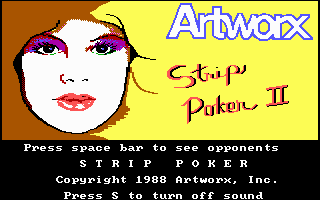
For a title screen, I turned back to that Russian disk and an EGA port of Artworx Strip Poker II. This was the era before Internet porn, so an adolescent took whatever nudity he could scrounge up. A few adjustments in Deluxe Paint, and there was little question as to the game’s contents.
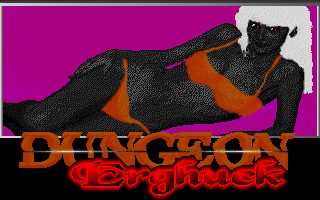
At first, that’s all there was to Erghuck; fantasy porn rooms. Gradually I refined the game. It gained a story, and as with Dusk Rose I set it in a corner of the world of Cireneg’s Rings.
Choosing to hide my identity entirely, I prepared to release the game under the “Janet L. Groth Productions” label. I never quite dared to upload it anywhere. For a while I also toyed with releasing Operation Killbot and Tony & Me under that banner, to a similar dead end.

Later I revised the game again, toned it down, and made it a coherent adventure. Whereas Erghuck began as a pile of naughty bits, I rehabilitated it into a mildly suggestive adventure along the lines of Steve Meretzky’s Leather Goddesses of Phobos, except lame and pointless. Although the content no longer bothered me, there was no real object to the game except to escape, and that’s no real challenge.
Still, in its final form it again brought life to some of my old characters, and it served to hint at further dimension to an existing world. If that’s my lowest ebb as a game designer, I guess I could be worse off. And indeed, from here things just get better.
The story continues in Part Seven…
To catch up on the story to date, you can view the archive here.
Time passed. I conducted some experiments, learned a few things, and became more confident with the tools. I completed a few original games, and toyed with some tributes. When I stumbled into my next run of insertion games, I was more prepared. I had a better sense of what was and was not possible with RSD’s tools. I had a slightly better sense of design. Creatively and technically, I was in a place to be more ambitious.

It’s unclear where Gridline came from. I get the feeling that the title screen may have come before the game itself, so maybe it began with some experiments in Deluxe Paint. Maybe I was thinking of some other game, like the early Genesis puzzler Zoom! — at least stylistically. Structurally, ToeJam & Earl may have had some influence.

Alternatively, the background grid may have left over from Explorer Jacko. Perhaps the tiles were meant for a dungeon level that I never completed.

Whatever the game’s origin, it is perhaps the most original I had developed to this point. Whether it is successful is another question. For a while I was rather proud of it, though. Of my early insertion games, it is the only one that I considered “canonical” and included on lists of available software.

The character is again based on the familiar template. I believe I had recently come back in contact with a grade school associate who I had not seen in five years, and so meant to send him the game as a gift. His input was zilch and his presence had little to no effect on the game’s design. In this case I felt free to get as weird as I liked.

I decided that the grid setting was a sort of outer space purgatory, to which my associate had been spirited away for reasons unknown. The grid was full of mostly-original monsters who could turn a person to stone, and indeed littered with statues representing previous explorers. The idea, I think, was that every time the player died, the character would petrify on the spot — and then the next time around, the statue would remain on the field. That element never quite came together.

Something that sort of did work out was the combat. In place of the projectiles in my earlier games, here it’s all about close-quarters fighting. Furthermore, the attacks are mapped to four directionals for a sort of Robotron-style experience. Both the attacks and the mapping are a little wonky in the implementation, but compared to what I’d done before this is a pretty big stylistic leap.

Amongst the melee combat, the small environments, and the distinctive monsters — as well as the dire consequences of being touched — Gridline winds up feeling sort of conceptual. Whether it works or not, it’s small, focused, and distinctly odd. Little wonder it pleased me at the time.
Less pleasing were my next two projects, both of which felt altogether foisted on me. Someone sat me down, told me what do do, and watched while I did it. The results so embarrassed me that, despite later attempts to salvage the material, these games are amongst only three finished projects that I never released.
It is perhaps significant that both games use the same background tiles, most of which I borrowed from earlier projects which in turn borrowed most of their tiles from A-J’s Quest. There is an element of rapid prototyping, especially with someone watching over one’s shoulder, and there is an element of sheer apathy.

I think what most bothered me about these games is that the actual design was less a concern than their exhibition of my associates’ proclivities. Tony & Me, for instance, was meant to be a Double Dragon style brawler — not the most sensible option for the given tools, but I was willing to try — but what it was really about was its protagonist’s real-life ambitions to get laid. That, and to demonstrate what a tough dude he was.

I suppose I could have gone any direction with this game. Were I a little more clever I could have undermined the premise with some lampoonery, or used it as an opportunity to try some new techniques that would pan out in later projects. Instead, I just chose to get it over with.

I brought over the melee combat from Gridline, but in interest of simplifying the controls and out of sheer apathy I condensed the attacks down to one button. The results are underwhelming. The character will close his eyes, extend both arms, and then depending on which direction he had been walking, a fist or a weapon will appear at the end of one arm. When I write it out like that, the animation sounds more interesting than it is. In practice, it comes off as lazy. Which is accurate.
Likewise the enemies are borrowed wholesale from Gridline and A-J’s Quest, which confirms the game’s dating if my vague memory and extrapolation of the game’s mechanics weren’t enough.

One new element is the character sprites. I think by this point I was tired of rehashing the same template. It was too recognizable, it was too limited, and it just wasn’t original. Also, I may have chosen to demonstrate to my associate the character design process. If that was the case, then I can understand why I may have begun from scratch — especially as by this point I felt I had a grasp of basic animation.

Of note is that my associate insisted that I include myself as a playable character — inspired, perhaps, by the variety in Final Fight or Streets of Rage. My implementation was, for whatever reason, to position the player as a ghost or angel who has the opportunity to be revived as either of the two characters — complete with voiceover about his predicament.

Since the engine only supports one player at a time, and since there is no practical difference between the characters, the effect of the choice is somewhat diminished. I chose to distinguish the two threads by swapping out the monsters (he gets Gridline; I get A-J’s Quest) and by changing the ending. Play as him, you get a happy ending. Play as me — well, you just play a level and then stop.

Later on I removed the parts that made me feel icky, changed around the identities of involved parties (both he and the particular girl he had in mind), and adjusted the mechanics enough to allow the game to sort of stand alone. None of it helped, though, and the game sat on my hard drive for a decade and a half.
Mind you, it had company. If Tony & Me was embarrassing, my next game was probably one of the more horrible things I’ve done.

There’s sort of a long story here. You know when you’re little, and your parents match you with other kids your age, and somehow they’re your friends, whether you actually like them or not? That was never more the case than with this client. Let’s call him Mark. My, he was a pushy one. Mark had a grudge against another fellow in our grade, we’ll say Harold. I never quite understood why.
As I say, I had no problem with Harold, but being young and conflict avoidant, I tended to just go along with Mark’s nonsense until Mark went away. One day Mark invited himself over and decided that I needed to make a game in which he killed Harold. I think I ignored him at first, but Mark had a way of digging in his heels and I had a way of folding.

The idea was that Mark would catch Harold in various lewd acts, at which point Mark would slowly blast Harold to pieces. I’m going to spare you the details, but it got unpleasant. Mark wanted to be portrayed as basically a Harold-slaying machine. He also wanted a sort of 3D, behind-the-back perspective reminiscent of Dead Angle.

In the tradition of games like Street Fighter II, interspersed with the normal levels were various bonus stages. In one stage Mark attacked Harold’s house and killed his mother. In another he simply chased Harold through a town and field, throwing sharp objects at him. In portraying Mark, I drew roughly from my memories of the arcade version of Sega’s E-SWAT, a sort of Japanese response to Robocop. Mark certainly liked his Robocop.

Which is not to say that I put any effort into the project. In fact I borrowed nearly all the game’s resources from Tony & Me, a project that received little enough attention. I think every step of the process I was simultaneously dragging my heels and looking for ways to avoid thinking about what I was doing.

Ultimately I filed Operation Killbot way in the back of my directory structure, unwilling to throw anything away but unsure what to do with the game. Eventually, as with Tony & Me, I made some effort to clean the game up. I removed some of the more uncomfortable imagery, changed around the premise and identities, and tried to tidy the mechanics.
That last part was the most damning, though, and explains why, even after several passes at fumigation, I never released the game. It simply doesn’t work, on any level. Mark’s requests were impossible within the framework I was using, but I didn’t care. I was only concerned with shutting him up and getting him out the door. Granted, in retrospect you can take Killbot as a curious experiment. It comes off as a sort of shooting gallery game, like a poorly designed Hogan’s Alley or Chiller without the light gun.

Maybe with extensive revision I could have salvaged the basic format. The level that works the best is the first bonus stage, where the player attacks the house. This is not to suggest that the level actually works, but the variety of targets — some stationary, some moving — does suggest a better direction for design.
It seems that even in the worst failures one can find, if not salvation, some glimmers of inspiration. This is a reassuring thought, as we have yet to hit the bottom of the well.
The story continues in Part Six…
Out of the 38 games I produced in the 1990s, I only finished 30. (If you want to get technical, I finished 31 then unfinished one.) Of the eight unfinished games, four had an actual chance at completion. I had the whole game planned out, and most of the infrastructure in place; all I needed to do was build the levels.
One of those four is a Blaster Master tribute called RÅdïp: Rover of the Deep. It came out of a sort of competition with another Game-Maker user, to design the best Blaster Master pastiche. His game hewed very closely to the source material. I took the basic concept and a variation on the vehicle design, and I wandered.
The plan was for six main levels, five bosses, and four vehicle upgrades. I finished everything except the levels, the bosses, and some elements of the presentation. Then I got distracted, and the game sat on the shelf for 15 years.
A few months ago I dug it up again, and I realized that the game ain’t half bad. For a Game-Maker game it controls unusually well. The existing monsters and background tiles are distinctive and meticulously built. The existing levels were pretty good, if rough around the edges — and certainly unlike something I would design now.
So I tidied up the levels, making sure that platforms and monsters were placed sensibly, and then I began to design a new one. The slot was already there; I just had to fill it.
In the game’s structure, level 3 is the first new level after the player gains the hover upgrade, allowing much more free movement through the terrain. It made sense, then, to capitalize on that new element and create a free-flowing map, not so dependent on platforms as on environmental hazards and barriers.
There is a contrast, though. For all the player’s new freedom, in a way the new map should be more constrained than ever. One concern is to give the level a sense of structure. It means nothing if the player can go anywhere, if there is nowhere specific to go. So throw in some long vertical corridors, or awkwardly connected rooms, to underline the potential of the player’s new mobility.
The other concern is to give the player a challenge that offsets the new ability. You don’t want the game to get easier just because the player is more powerful. Sure, earlier sections become a cinch — but a new rule should change the game’s focus, and give the player something new to master just around the time the player starts to feel comfortable. So the new level should present new sorts of problems that can only be solved with the new concepts at play.
None of this was a big priority. I have articles to write, a life to attend to, skills to learn. I don’t need to spend too much time messing with old, abandoned projects. So maybe once a week I would spend an hour or so tinkering with the map, adding another screen or two. It has taken a few months. The other day I finished the level. And here it is:
The entrance is toward the lower middle; the boss door is toward the upper left.
It may not be the strongest level in the world; much of it was improvised, rather than planned out deliberately. Still, that improvisation was informed by certain principles and, I think, a pretty good sensibility. Which is to say, I rather like it.
I’m uncertain whether I ever will finish the game; it’s been a decade and a half, so there’s no rush. And now that I’ve finished this level, I think I may have satiated my interest for the moment. Further discouraging me is that, after all, this is a pastiche. If I could take the rover out of the game, and turn the project into something wholly original, then maybe I would feel less reluctant. And yet then, the game would lose much of its identity — so there’s no point.
Again, though, I think the game is pretty decent for what it is — even half-finished. You can play it here, if you like. Press F6 and select the appropriate slot to skip straight to level 3.
Alternatively, here‘s a level 3 playthrough on Youtube.